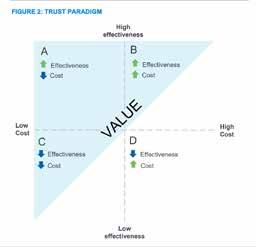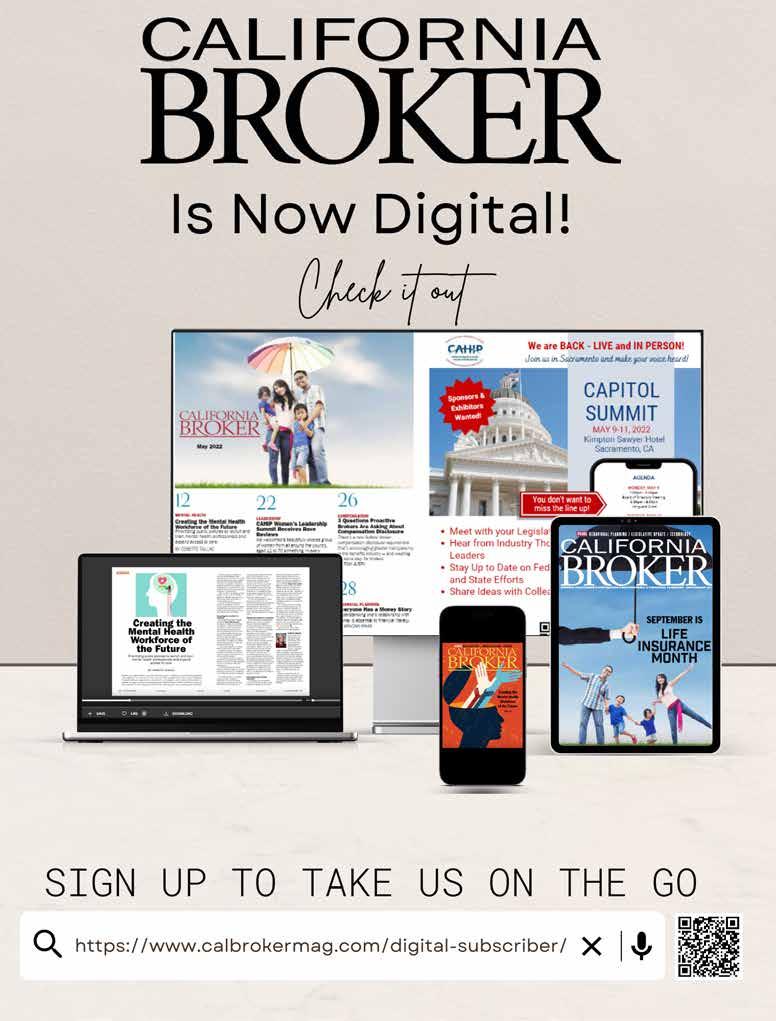
SERVING CALIFORNIA’S ANNUITY, LIFE AND HEALTH INSURANCE PROFESSIONALS / MARCH 2023 Innovation
[&] Effect Elements [Passion. Authenticity. Collaboration. Trust.]

The [&] Effect is a feeling. It’s the confidence you have working with authentic people who thrive on collaboration. It’s the security of having your business handled by a team passionate about your success. It’s the gift of time you’re granted because you have a partner you can trust.
It’s a phenomenon only experienced with Word & Brown by your side.
48 | CALIFORNIA BROKER MARCH 2023 CalBrokerMag.com Experience Word & Brown | wordandbrown.com Northern California 800.255.9673 | Inland Empire 877.225.0988 | Los Angeles 800.560.5614 | Orange 800.869.6989 | San Diego 800.397.3381

































































































































































































































MARCH 2023 CALIFORNIA BROKER | 3 CalBrokerMag.com Insurance companies vary by region. CoveredCA.com/ForSmallBusiness | 844.332.8384 Health plan options that fit your small business clients. With Covered California for Small Business, we help tailor health plan options so employers and employees can get the coverage they want at a price that fits their budget. Our flexible coverage options work with businesses as they grow to offer coverage that will adapt to their needs as well as care for and retain quality employees.
2023
TABLE of CONTENTS
13
From CMS
The CMS Framework for Health Courtesy of CMS.gov
Equity provides a strong foundation for leaders and trusted partners dedicated to advancing health equity, expanding coverage and improving health outcomes.
14 FROM THE PUBLISHER Digital Plus Print Make Cal Broker Top Choice for California Life and Health Brokers
By Phil Calhoun
Our goal is to provide unique, useful and entertaining information.
16 YOUR HEALTH
5 Steps to Living a Long, Healthy Life — With a Little Bit of Humor!
By Dafne Canales and Xavier Serrano
Five steps to longevity, including resources life and health insurance professionals can use.
18
LICENSING
Important Licensing CE Change for California Agents –Fraud-Prevention Ethics Training
By Paul Roberts
Ethics Continuing Education (CE) requirements for licensed health insurance professionals in the state changed by Calif. Dept. of Insurance.
Cal Broker’s commitment is to be the leading source of news and information for California brokers and agents operating in the health, life, and annuity industry. We are committed to connecting Life and Health insurance professionals to valuable resources and solutions they can provide to their insurance clients.
20 LEGISLATION
2023 National Healthcare Trends and Legislative Watch
By Misty Baker
Six national issues and trends you and your clients should be keeping an eye on.
22 LEGISLATION
Salary Transparency Laws
By
Andres Lares
Tips to help group insurance professionals support employers.
24
COMMISSION PLANNING
Planning to Exit Your CommissionBased Business?
Sharing success with a colleague can pay off big
By Phil Calhoun
Preparing for a life change that involves transitioning your hard-earned commissions and loyal clients? Sharing your success with a colleague can be a great solution.
26
Reference-Based Pricing in SelfFunded Health Plans; A Key to Cost Savings?
PART I OF 2
By Omar Arif and Mike Sigal with Dorothy Cociu
RBP is a health plan financing strategy leveraged by self-funded employers that can result in significant reductions in claim costs.
28
Innovative Health Benefit Packages
5 emerging strategies to help employers
By Steve Cain
Help attract and retain team members, spur productivity, and reduce the incidence of preventable medical events and costly chronic conditions.
30 VISION
Optical Solutions and Benefits to Protect Employee’s Eyes from Harmful Blue and UV Light
By Jonathan Ormsby
To help brokers show the value of vision benefits to their client employers, Transitions Optical conducts annual research studies of employee benefit preferences.
4 | CALIFORNIA BROKER MARCH 2023 CalBrokerMag.com
MARCH
CALIFORNIA’S ANNUITY, LIFE AND HEALTH INSURANCE PROFESSIONALS
SERVING
32 PHARMACY
What to Expect From a PBM Account Team
Recommend the right match for your group clients
By Gregory O. Callahan
Brokers and pharmacy benefit managers (PBMs) play a significant role to help plan sponsors (group employers) manage their pharmacy benefit.
34
Virtual Care Technology Focuses on Prevention
2023 year of innovation
By Michael Gorton
Brokers in the know will be better able to advise their group clients about ways to package benefits to take advantage of these advancement
38
INFLUENCER OPINION
FORBES PREDICTION: Medicare Advantage Will Remain Under A Microscope
Dawn Maroney, CEO of Alignment Health Plan and president, Markets of Alignment Health, shares her opinion.
40 FINANCE
Putting Solid Ground Under Financial Instability
By Matthew Owenby
There are many considerations for leaders as to how to help their people find that stability they crave.
42
Looking for Organic Growth?
Here’s how: Consistently deliver the right message to the right audience
 By Paul Seegert
By Paul Seegert
During high times and low times in the economic cycl,e organic growth is always listed as a top priority for agencies of all sizes
44 PUBLISHER’S PICK: BOOK REVIEW “Built To Sell: Creating a Business That Can Thrive Without You”
PUBLISHER
Phil Calhoun HealtH Broker PuBlisHing, llC publisher@calbrokermag.com
EDITOR Linda Hubbard Lalande editor@calbrokermag.com linda@calbrokermag.com
ART DIRECTOR Randy Dunbar Randy@calbrokermag.com
PRODUCTION ASSOCIATE Zulma Mazariegos Zulma@calbrokermag.com
DIGITAL DIRECTOR Carmen Ponce Carmen@calbrokermag.com
CIRCULATION calbrokermag@calbrokermag.com
ADVERTISING
By
John Warrillow; Review by Phil Calhoun
Understand the importance of developing a comprehensive renewal process each year where the owner is the center.
Health Broker Publishing 14771 Plaza Drive Suite C Tustin, CA 92780 (714) 664-0311 advertising@calbrokermag.com calbrokermag@calbrokermag.com
Subscriptions: U.S. one year: $100. Send change of address notification at least 20 days prior to effective date; include old/new address to:
Health Broker Publishing 14771 Plaza Drive Suite C • Tustin, CA 92780 (714) 664-0311
California Broker (ISSN #0883-6159) is published monthly. Periodicals Postage Rates Paid at Burbank, CA and additional entry offices (USPS #744-450).
POSTMASTER: Send address changes to California Broker, 14771 Plaza Drive Suite C • Tustin, CA 92780
©2023 by Health Broker Publishing. All rights reserved. No part of this publication should be reproduced without consent of the publisher.
No responsibility will be assumed for unsolicited editorial contributions. Manuscripts or other material to be returned should be accompanied by a selfaddressed stamped envelope adequate to return the material. The publishers of this magazine do not assume responsibility for statements made by their advertisers or contributors.
Printed and mailed by Southwest Offset Printing, Gardena, Calif.
MARCH 2023 CALIFORNIA BROKER | 5 CalBrokerMag.com IN EVERY ISSUE Industry News 7 Ad Index 46

Courtesy of medicalnewstoday.com
What are the benefits of eating healthy?
Following a healthy diet has many benefits, including building strong bones, protecting the heart, preventing disease, and boosting mood.
A healthy diet typically includes nutrientdense foods from all of the major food groups, including lean proteins, whole grains, healthy fats, and fruits and vegetables of many colors. Healthy eating habits also include replacing foods that contain trans fats, added salt, and sugar with more nutritious options.
Following a healthy diet has many benefits, including building strong bones, protecting the heart, preventing disease, and boosting the mood.
This article discusses the top 10 benefits of a healthful diet and the evidence behind them. (This excerpt includes Heart health details only. Refer to the full article at https://www.medicalnewstoday.com/ articles/322268 for all 10 benefits and details, which include heart health, reduced cancer risk, better mood, improved gut health, improved memory, weight loss, diabetes management, strong bones and teeth, getting better sleep.)
HEART HEALTH
According to the Centers for Disease Control and Prevention (CDC), heart disease is the leading cause of death for adults in the United States.
The American Heart Association (AHA) states that almost half of U.S. adults live with some form of cardiovascular disease.
High blood pressure, or hypertension, is a growing concern in the U.S. The condition can lead to a heart attack, heart failure and stroke
It may be possible to prevent up to 80% of premature heart disease and stroke diagnoses with lifestyle changes, such as increasing physical activity and healthful eating.
The foods people eat can reduce their blood pressure and help keep their hearts healthy.
The Dietary Approaches to Stop Hypertension (DASH) diet, includes plenty of
heart healthy foods. The program recommends:
● eating plenty of vegetables, fruits, and whole grains
● choosing fat-free or low fat dairy products, fish, poultry, beans, nuts, and vegetable oils
● limiting saturated and trans fat intake, such as fatty meats and fullfat dairy products
● limiting drinks and foods that contain added sugars
● restricting sodium intake to less than 2,300 milligrams per day — ideally 1,500 mg daily — and increasing consumption of potassium, magnesium, and calcium
High-fiber foods are also crucial for keeping the heart healthy.
The AHA states that dietary fiber helps improve blood cholesterol and lowers the risk of heart disease, stroke, obesity, and type 2 diabetes
The medical community has long recognized the link between trans fats and heart-related illnesses, such as coronary heart disease.
Limiting certain types of fats can also improve heart health. For instance, eliminating trans fats reduces the levels of low-density lipoprotein (LDL) cholesterol. This type of cholesterol causes plaque to collect within the arteries, increasing the risk of a heart attack and stroke.
Reducing blood pressure can also promote heart health. Most adults may achieve this by limiting their salt intake to no more than 1,500 mg per day.
Food manufacturers add salt to many processed and fast foods, and a person who wishes to lower their blood pressure should avoid these products.
THE HEALTH OF THE NEXT GENERATION
Children learn most health-related behaviors from the adults around them, and parents who model healthy eating and exercise habits tend to pass these on.
Eating at home may also help. In 2018, researchers found that children who regularly ate meals with their families consumed more vegetables and fewer sugary foods than their peers, who ate at home less frequently.
QUICK TIPS FOR A HEALTHFUL DIET
There are plenty of small ways to improve a person’s diet, including:
● swapping soft drinks for water or herbal tea
● ensuring each meal consists of some fresh produce
● choosing whole grains instead of refined carbohydrates
● consuming whole fruits instead of juices
● limiting red and processed meats, which are high in salt and may increase the risk of colon cancer
● eating more lean protein, which people can find in eggs, tofu, fish, and nuts
A person may also benefit from taking a cooking class and learning how to incorporate more vegetables into their meals.
SUMMARY
Healthy eating has many benefits, such as reducing the risk of heart disease, stroke, obesity, and type 2 diabetes. A person may also boost their mood and gain more energy by maintaining a balanced diet.
A doctor or dietitian can provide further tips for eating a more healthy diet.
Source: https://www.medicalnewstoday. com/articles/322268

MARCH 2023 CALIFORNIA BROKER | 7 CalBrokerMag.com CURATED NEWS FROM THE INDUSTRY
March is NATIONAL NUTRITION MONTH
Call to Action for Advisers
A medical procedure that should have cost $100 — was billed for $8K
 By Kim Eckelbarger from BenefitNews.com
By Kim Eckelbarger from BenefitNews.com
“ My family’s recent ER experience serves as a stark reminder of the importance of arming employee populations with knowledge when seeking care. … That got me thinking: how many people know to ask if any follow-up care that’s needed could be handled somewhere other than an expensive hospital setting? When the treating physician says you can come back for care, that’s what most people do. … We were charged 10 times the average cost for this procedure (treating my husband’s ingrown chest hair) in a hospital that uses scare tactics on patients while they are in pain.
“There must be a way to render this perverse delivery of the U.S. healthcare system obsolete, and I hope benefit advisers everywhere will lead the charge. The breakdown starts when a primary care physician can’t treat you at the moment when you really need care.
Researchers say a new vaccine shows promise in blocking fentanyl from entering a person’s brain.
They say the vaccine could help reduce overdoses and aid in addiction recovery.
Experts, however, point out that the new vaccine has only been tested on rats, so more research is needed on its effectiveness on humans.
They also note that people who’ve had vaccine could switch to other opioids.
The researchers said the vaccine could have major implications on helping solve the nation’s opioid crisis, and “could not be timelier or more in demand.” The team said opioid use disorder (OUD) is treatable, but an estimated 80% of people addicted to the drug experience a relapse after treatment
“The point of entry into care is critical to get right, and if the walk-in clinic doesn’t educate you on what to expect during the healing process, then it escalates at the hospital and simply runs amok.

“Avoiding fiascos like my husband’s recent health scare isn’t easy given the level of complexity involved in navigating the U.S. healthcare system. At the very least, it serves as a stark reminder about the importance of arming the employee populations we serve (as advisors) with the knowledge they need to seek appropriate care, ask informed questions and walk away from potential medical emergencies unscathed.”
Full story: www.benefitnews.com/advisers/opinion/ why-a-100-medical-procedure-was-billed-for-8k
The study, published in the journal “Pharmaceutics,” was led by the University of Houston researchers. In it, the team of scientists reports that the vaccine targets the synthetic opioid fentanyl by blocking its ability to enter the brain.
“Over 150 people die every day from overdoses of synthetic opioids including fentanyl, which is 50 times stronger than heroin and 100 times stronger than morphine,” the researchers said. “Consumption of about 2 milligrams of fentanyl (the size of two grains of rice) is likely to be fatal depending on a person’s size.”
Full article: www.healthline.com/health-news/ why-fentanyl-vaccine-could-be-a-gamechanger-for-opioid-epidemic
Era of ‘Free’ Covid Vaccines, Test Kits, and Treatments Is Ending. Who Will Pay the Tab Now?
Insurers, employers, and taxpayers will all be affected as drug manufacturers move these products to the commercial market. The White House announced this month that the national public health emergency, first declared in early 2020 in response to the pandemic, is set to expire May 11. When it ends, so will many of the policies designed to combat the virus’s spread. Full story Californiahealthline.org: https://bit.ly/3YUF3Iy
8 | CALIFORNIA BROKER MARCH 2023 CalBrokerMag.com CURATED NEWS FROM THE INDUSTRY
Fentanyl Vaccine a Potential 'Game Changer' for Opioid Crisis
6 Great Questions To Help You Measure Annual Enrollment Success
From bswift.com
Find out how to improve annual enrollment, so it’s even better next year. Here are a few simple questions you and your HR team can ask.
1. How was employee participation in annual enrollment?
2. Are employee benefits costs and usage balanced?
3. What feedback did employees provide?
4. How many employees used a benefits decision support tool?
5. Did employees contact your benefits service center?
6. How many employees logged in during annual enrollment to review their benefits and make changes?
Benefits admin bottom line: Measure what matters
Full story: www.bswift.com/Another great eNewsletter article.insights/6great-questions-to-help-you-measureannual-enrollment-success/
Women In Leadership Featured at the Ellevate Women’s Leadership 2023 Summit, March 13-15, Las Vegas
Jessica Word, CEO of Word & Brown General Agency (one of our advertisers), will be one of the 15 powerful speakers at the upcoming Women's Leadership Summit.
Speakers will include insurance industry luminaries Jennifer Berman, Erica Brown, Karyn Buxman, Susan Combs, Sandra Gebhardt, Kelly Gorman, Lisa Hutcherson, Cori Moyes, Becky Patel, Naama Pozniak, Irma Romero, Heather Siems, Breanne Swenson and Cora Tellez.
Contact: hello@ellevatefoundation.org.
Look for coverage of the event in an upcoming issue.
14 Axios: Workplace Plans Paid More Than Medicare For Physician-Administered Drugs, Study Finds
Employer-sponsored health plans pay significantly more than Medicare for costly physician-administered drugs, threatening access to lifesaving treatments, according to a newly published analysis of claims data and Medicare Employer-sponsored health plans pay significantly more than Medicare for costly physician-administered drugs, threatening access to lifesaving treatments, according to a newly published analysis of claims data and Medicare files.
Zoom in: While high-volume drugs had relatively low unit prices, workplace plan markups over Medicare prices were especially high for these drugs, the Health Care Cost Institute analysis published in JAMA Health Forum found.
Axios article: https://bit.ly/3KdbLAW JAMA study: https://bit.ly/3ItEos8
2023 INDUSTRY CALENDAR WEBINARS
March 4
9:00-1:30 pm PST, by zoom: WIFS-LA Women’s Forum
“Embrace Empowerment”
Info: janet@wifs-losangeles.org
CONFERENCES
March 13-15
Ellevate Women’s Leadership 2023 Summit JW Marriott just outside Las Vegas. In Person.
Register: https://bit.ly/3ZEW7n4
April 11-14
Virtual Fourth National Medicare Advantage Summit by Global Health Care, Virtual/Online Live Video; Media Partners: Harvard Health Policy Review, Health Affairs and Inside Health Policy. 1-(800) 503-0078. Registration@hcconferences.com Register: medicareadvantagesummit.com
April 25
LAAHU 2023 Annual Symposium Pasadena Convention Center.
Register: https://laahu-annual-symposium.constantcontactsites.com
May 8-10
CAHIP Capitol Summit Sacramento Register: www.cahu.org/capitol-summit
MARCH 2023 CALIFORNIA BROKER | 9
CalBrokerMag.com
FOUR HR TRENDS FOR 2023
In the past couple of years, HR functions across the world have been tested like never before. Leaders have faced disruptions from abrupt shifts to remote work, economic volatility, the Great Resignation and geo-political events. These factors, along with rapid digitization, have made traditional, office-based HR less significant. And with shifting employee expectations, HR has also struggled with recruitment and retention across industries. However, technology has also led to the automation of repetitive, time-consuming tasks so that HR can play a more strategic role in an organization.
As cofounder of a platform for financial well-being at work that provides benefits for over 300 companies, Vidit Agrawa discusses some HR trends expected in 2023.
Hybrid Offices
Post Covid-19 pandemic, technology has completely changed how we collaborate and communicate.
Future Of Work
Over the next few years, I see AI integration in HR remaining a sweeping trend.

Total Rewards
The last two years have made it clear that employees want choice and flexibility in the workplace. No single benefit stack will fit everyone when it comes to benefits and compensation.
Employee Engagement
An engaged employee brings with them passion and commitment, which positively impacts productivity and overall stakeholder value.
Vidit Agrawa / Forbes Read Article: https://bit.ly/40TcIV7
Words by Gavin Haines, Positive.news

“What does all this mean? Is what I thought to myself the other night, as I drifted off into an agitated, unsettled sleep.
“I was preoccupied with ChatGPT, the new artificial intelligence-powered chatbot that can write poetry, news articles, essays, songs, computer code and much else besides. All you have to do is feed it some instructions and it’ll do the job (albeit to a dubious standard… for now) in the time it takes to ask yourself: “how safe is my career?”
“The firm behind it, Open AI, was founded by, among others, the billionaire ‘tech bro’ Elon Musk, who has expressed concerns about the existential risk posed to humanity by AI (but seems to be ploughing on regardless). Would his next space project, I wondered, be powered on the stolen ambitions of poets?”
Dive deeper: https://www.positive. news/society/the-robots-are-coming-itstime-to-be-more-human-chatgpt/
10 | CALIFORNIA BROKER MARCH 2023 CalBrokerMag.com
AI is here. It’s time to be more human
Digital Technology Human Factor + BenefitMall.com | 800.350.0500 Premier broker support. Less of everything that holds you back. More of everything that makes you great.
Failure to Survive Product Line
With liberal underwriting standards and unique flexibility, the Failure To Survive coverage provides a death benefit, and can accommodate impairedrisk cases that would typically be declined or postponed by traditional market carriers.

• Contract Indemnity FTS
• Key Person FTS
• Buy/Sell FTS
• Business Loan FTS

MARCH 2023
® CA License
Petersen International Underwriters (800) 345-8816 F www.piu.org F piu@piu.org When Traditional Carriers Can’t...or Won’t ® ® CANNABIS INDUSTRY
#: 0591207
Exit Planning Training Sponsored by Strazzeri Mancini, LLP
In January, Strazzer Mancini, LLP introduced succession planning for small business owners for CalBroker readers. Group benefit brokers can learn more about business succession planning and work with a team to bring resources to their business owner clients.
This is an open invitation for group health brokers to both access online information on succession planning and join monthly calls and in person Exit Planning Institute Chapter meetings.
Learn from independent attorneys, CPAs, bankers, financial planners, investment advisers, insurance and real estate professionals, presenting training sessions every week. CalBroker suggests joining a free Local Exit Planning Institute (EPI) meeting or Southern California Institute meeting (SCI.) The links below lead to resources you use now. CalBroker readers are welcome to upcoming meetings.
For information, see links:
1. Weekly Thursday Insights Schedule and Registration: www.SCInstitute.org/ThursdayInsights (https://bit.ly/3YUFBOS)
2. EPI Orange County Chapter Meeting Schedule and Registration: 2nd Thursday of month in-person ONLY (https://bit.ly/3Kav8e1)
3. EPI San Diego Chapter Meeting Schedule and Registration: 3rd Wed of month 2:30 – 4:00 p.m. Zoom only (https://bit.ly/3xuXCrm)
4. EPI Los Angeles Chapter Meeting Schedule and Registration:4th Wed of the month: zoom & in person (https://scinstitute.org/episdchapter/)
For additional information call: 858-200-1900.
What Does Cutting Medicare Actually Mean?
Lately, Democrats and Republicans have been accusing each other of “cutting Medicare.”
But what does that even mean? A “Medicare cut” might simply mean slowing the rate of growth of spending in the program compared to what it would have been. Spending may still be going up, but perhaps not as fast.
When Americans hear those words, they may think they’ll automatically lose benefits or pay more out-ofpocket. But cuts to the major federal health insurance program come in different forms — such as changing providers’ pay, increasing the eligibility age or increasing cost-sharing for certain services or raising premiums — and have different effects on the program, providers and those with Medicare coverage.
Full article: https://www.washingtonpost. com/politics/2023/02/13/what-does-cuttingmedicare-actually-mean tions-for-2023-newrealities-and-priorities-for-health-plans/
WebMD has a Pill Identifier tool
WebMD’s Pill Identifier can help you put a name to an unknown medication. It identifies prescription and over-the-counter (OTC) meds that you take in solid form by mouth, like tablets and capsules.

Simply enter some basic details about the pill, and the Identifier tells you what it might be. It shows you a list of close matches, or it singles out an exact possible match. Each result includes a pill’s picture, its brand and generic names, strength (dose), and other info.
More: www.webmd.com/pillidentification/default.htm
12 | CALIFORNIA BROKER MARCH 2023 CalBrokerMag.com
Newly Released: CMS Framework for Health Equity
Courtesy of CMS.gov
“As the nation’s largest health insurer, the Centers for Medicare & Medicaid Services has a critical role to play in driving the next decade of health equity for people who are underserved. Our unwavering commitment to advancing health equity will help foster a health care system that benefits all for generations to come.”
— Dr. LaShawn McIver, Director, CMS Office of Minority Health

The CMS Framework for Health Equity provides a strong foundation for our work as a leader and trusted partner dedicated to advancing health equity, expanding coverage, and improving health outcomes. This includes strengthening our infrastructure for assessment, creating synergies across the health care system to drive structural change, and identifying and working together to eliminate barriers to CMSsupported benefits, services, and coverage for individuals and communities who are underserved or disadvantaged and those who support them.
Across our Centers and Offices, we are committing to taking an integrated, action-oriented approach to advance health equity among members of communities, providers, plans, and other organizations serving such communities, who are underserved or disadvantaged.
CMS released an updated framework to further advance health equity, expand coverage, and improve health outcomes for the more than 170 million individuals supported by CMS programs. The framework sets foundation and priorities for CMS’s work strengthening its infrastructure for assessment, creating synergies across the health care system to drive structural change, and identifying and working to eliminate barriers to CMS-supported benefits, services, and coverage.
Priority 1: Expand the Collection, Reporting, and Analysis of Standardized Data
CMS strives to improve our collection and use of comprehensive, interoperable, standardized individual-level demographic and social determinants of health (SDOH) data, including race, ethnicity, language, gender identity, sex, sexual orientation, disability status, and SDOH. By increasing our understanding of the needs of those we serve, including social risk factors and changes in communities’ needs over time, CMS can leverage quality improvement and other tools to ensure all individuals have access to equitable care and coverage.
Priority 2: Assess Causes of Disparities Within CMS Programs and Address Inequities in Policies and Operations to Close Gaps
CMS is committed to move beyond observation and into
action, assessing our programs and policies for unintended consequences and making concrete, actionable decisions about our policies, investments, and resource allocations. Our goals are to explicitly measure the impact of our policies on health equity, to develop sustainable solutions that close gaps in health and health care access, quality, and outcomes and to invest in solutions that address health disparities.
Priority 3: Build Capacity of Health Care Organizations and the Workforce to Reduce Health and Health Care Disparities
CMS has a commitment to support health care providers, plans, and other organizations who ensure individuals and families receive the highest quality care and services. Health care professionals, particularly those serving minority and underserved communities, have a direct link to individuals and families and can address disparities at the point of care. CMS policy, program, and resource allocation decisions must build capacity among providers, plans, and other organizations to enable stakeholders to meet the needs of the communities they serve.
Priority 4: Advance Language Access, Health Literacy, and the Provision of Culturally Tailored Services
CMS must ensure that all individuals we serve, including members of communities that are underserved, can equitably access all CMS benefits, services and other supports, and coverage. Language access, health literacy, and the provision of culturally tailored services play a critical role in health care quality, patient safety and experience, and can impact health outcomes. CMS has opportunities across our operations, direct communication and outreach to enrollees and consumers, and guidance to plans, providers, and other partners to improve health care quality, patient safety, and the experience individuals have within the health care system.
Priority 5: Increase All Forms of Accessibility to Health Care Services and Coverage
CMS has a responsibility to ensure that individuals and families can access health care services when and where they need them, in a way that is responsive to their needs and preferences. CMS must seek direct feedback from individuals with disabilities, including physical, sensory and communication, intellectual disabilities, and other forms of disability, to understand their experiences navigating CMSsupported benefits, services, and coverage and tailor our programs and policies to ensure equitable access and quality.
The CMS Office of Minority Health offers health equity technical assistance resources, aimed to help health care organizations take action against health disparities.
For assistance, visit go.cms.gov/omh or email HealthEquityTA@ cms.hhs.gov.
Source: https://www.cms.gov/about-cms/agency-information/ omh/health-equity-programs/cms-framework-for-health-equity
MARCH 2023 CALIFORNIA BROKER | 13 CalBrokerMag.com
From the Publisher
Digital Plus Print Make Cal Broker the Top Choice for Life and Health Brokers in California
Many of you may not know that as the owner of California Broker Media, I come from 25 years on the agency side. Since June of last year, my editorial focus has been to view the content of articles submitted by industry experts using a filter that ensures we offer the most valuable and relevant information to California brokers of life and health insurance.
Our team at Cal Broker thanks our readers, authors and advertisers who have helped California Broker Media Group grow into an industry leadership role. We look forward to your support in 2023 and beyond as we face challenges to our industry. As the year rolls out we all lean on our industry leaders and colleagues to develop products and services for our clients and at Cal Broker we commit to providing news and information to help our readers be successful.
Our goal is to provide unique, useful and entertaining information associated with health and life insurance themes to enable readers to continue to do the work necessary to be client advocates.
To pursue this goal, our team collects the most valuable information provided by expert authors, coupled with researched and curated content we develop, so that each magazine and newsletter we send out is filled with relevant content. This effort is an ongoing challenge and we are confident we will continue to meet this goal with your help and support.
Help Shape CalBroker Content: Feedback Tools for You
Your help is needed to create a vibrant feedback process.
We encourage your suggestions for improvements to enhance our ongoing mission to provide insightful, relevant, and informative content. To make that possible, we’re introducing interactive media tools to our platform. Through our digital offerings, you now have the opportunity to respond and be heard using on the spot feedback mechanisms.
It is through the support of our advertisers that we are able to bring our content to you. With our new interactive digital media tools, both our advertisers and authors can experience a more direct response from you.
Tools you can use
In the online digital version of our monthly magazine articles, as you read through the magazine we will be able to learn more about what is of interest to you when readers use the article links. Many of our advertisements will also have links that will go directly to the sponsor. In print, we will also provide contact information so you reach out directly to our advertisers.
Please take our surveys as your comments and suggestions will be reviewed, considered, acted upon and shared when appropriate. Your feedback will guide us to make adjustments in what we offer. With direct feedback, even our advertisers can make adjustments to enhance their offers to you.
Perspective on CalBroker
You can help us do a better job by reviewing our current Strengths, Weaknesses, Opportunities, and Threats (SWOT) Analysis.
Strengths
1. We have a robust brand and track record over 42 years, earning us the top position for all media focused on and directed to life and health insurance professionals in California.
2. We have strong working relationships with many professional associations in the industry. We are committed to strengthening these vital connections, and we look to build new relationships with Group Health, Medicare, HR, Life and Annuity organizations. Please suggest possible contacts.
3. Our target market reach positions us as the leader in California. Our solid base includes 25,000 print subscribers and 10,000 eNewsletter subscribers. We are building this base going into 2023.
4. Our website is vibrant and we plan to build on the 10,000 unique visitors monthly while seeking to streamline the content currently displayed.
Weaknesses
1. We appreciate your feedback. Please participate in our surveys, your input is valuable. More digital interaction will benefit readers and advertisers.
ADDITIONALLY when you come across valuable and enjoyable articles and news, we invite you to actively share with our editor at linda@calbrokermag.com so all of our readers can learn from and enjoy current, relevant information. You can remain anonymous, or ask to be credited for the information provided if it is used.
2. Costs of print and postage remain a major challenge. Many print media companies are moving to digital to save on the significant fixed costs of a print magazine. These costs remain a concern and we are looking for ways to offset these expenses.
14 | CALIFORNIA BROKER MARCH 2023 CalBrokerMag.com
BY PHIL CALHOUN
3 There is a risk to California Broker’s leadership position if we are not constantly looking to provide valuable content to you our readers. Building connections with authors and influencers in our industry is a must do to continuously provide our weekly and monthly offerings.
Opportunities
1. Use digital feedback tools to check in with readers and get feedback on articles and advertising.
2. Use general surveys to help us determine and cover the categories readers value.
3. Reach out for new sources of content and build more useful content based on reader feedback.
4. Digital and print media options will enable our readers to select the media they prefer.
Threats
1. Printing and postage costs continue to rise, and more print media is moving to digital as a result. We have a three-step process to learn more about our print readers and make plans to address this threat.
a. Track where we send both print and digital magazines and measure reader experiences.
b. Gather reader feedback over time to determine preferences on receiving our information. To date, our tracking of feedback has been spread between print and online reader preferences. We see wide ranges of responses and it looks like readers have many ideas to share about the topic of print and digital media. At this time, we ask that readers opt in to receive both and also let us know your preference.
c. We expect that by later this year our move to more digital options will prove positive. We still expect to have print subscribers, so this option will continue through 2023.
2. We need email addresses from our readers. Beginning with the March issue, we will email the print issue in digital form to our current email list. We need to continue to collect more emails so we reach all of our print readers.
To be part of the process of SHAPING THE FUTURE OF CALBROKER, please use this link to provide us with your email.
https://www.calbrokermag.com/digital-subscriber/
Please give the print and eMagazine a try and let us know your preference by emailing publisher@calbrokermag.com

1. Circulation Consistency: As mentioned here, California Broker Magazine will also come to our email subscribers as an eMagazine. We will make the eMagazine available on our website as usual AND we will also email it our monthly subscribers as well. Please give both formats a chance. If you want to unsubscribe to the eMagazine, you may do so. Please know the print magazine will continue to be mailed to subscribers.
2. Digital and Print: Note that the digital magazine has the same content as the print. The new digital version will be accessible on all media forms: mobile phone, laptop and desktop.
3. Essential Feedback: All readers will have the chance to respond to simple surveys to provide us feedback on articles and advertisements. We need your content ideas and your feedback on our published articles and advertising. This support will help us provide a stronger product for you.
4. Common Goals: Collectively, we need your input to continue to bring our industry the valued information needed to be able to perform as professionals, increase revenues and client impact through the work we perform, and build successful agencies that our families and employees can count on into the future.
5. Future Focused: When we focus on the tasks in front of us and keep in mind our goal, we can lead the way forward for many more years. For your clients, we strive to give you the resources needed to make an impact on their lives. And for you and your employees we hope to open new opportunities for you to grow, protect and sell your business.
Phil Calhoun, owner and publisher, California Broker Media Group publisher@calbrokermag.com
MARCH 2023 CALIFORNIA BROKER | 15 CalBrokerMag.com
5 Steps to Living a Long, Healthy Life — With a Little Bit of Humor!
BY DAFNE CANALES AND XAVIER SERRANO
As life expectancy continues to increase, the desire for a long and healthy life has become more important than ever. While genetics plays a role, there are a number of steps individuals can take to increase their chances of living a long and healthy life. In this article, we will explore the five steps to longevity, including resources life and health insurance professionals can use.
1. Sweet Dreams are Made of This: Get a Good Night’s Sleep
Who knew that snoozing could be such a lifesaver? That’s right, getting your beauty sleep isn’t just important for feeling fresh and ready to tackle the day ahead, it’s also crucial for keeping those pesky diseases at bay. So, grab your pillow and get ready to learn why sleep is the secret to longevity!
According to renowned sleep scientist, Matthew Walker, sleep plays a vital role in our overall health and well-being. When we sleep, our bodies work like little repairmen and women, fixing up any damage and making us feel brand new. And the best part? This all happens while we’re getting our Z’s, so we don’t have to lift a finger!
Studies have shown that those
time to hit the hay!
Sleep is more than just a way to recharge your batteries. It’s a crucial component of a healthy lifestyle and a key factor in promoting longevity. So, put down that book, turn off the TV, and catch some Z’s. Your body will thank you! By taking care of your sleep, you can ensure that you’re doing everything you can to keep yourself healthy and increase your chances of living a long, happy life.
2. Eat Like a King (or Queen) to Stay Healthy and Energetic

Feast like royalty to keep your body in top condition! Did you know that what you eat has a direct impact on your health and well-being? By munching on a rainbow of colorful fruits and veggies, whole grains, and lean proteins, you’ll be doing your body a big favor. These nutritious foods can help prevent diseases, infections, and fatigue, so you’ll feel fresh and ready to tackle the day ahead (Mayo Clinic, 2021).
Hydration is key when it comes to staying healthy and energized. Make sure to drink plenty of water throughout the day to keep your body hydrated and functioning at its best.
In addition to eating well, it’s also important to be mindful of what you’re not eating. Limit your intake of processed foods and added sugars. These foods are often high in calories and low in nutrients, which can lead to weight gain and other health problems.
Don’t skip meals! Eating regularly throughout the day can help keep your energy levels up. Skipping meals can lead to overeating and disrupt healthy eating patterns, which can negatively impact one’s overall health and well-being (Academy of Nutrition and Dietetics, 2021). Stick to a schedule and make sure to fuel your body every few hours with nutritious, energyboosting foods.
Eating like a king or queen doesn’t have to be difficult. Simply focus on incorporating healthy, whole foods into your diet and being mindful of what you’re putting into your body. Your health and energy levels will thank you!
MARCH 2023 CalBrokerMag.com YOUR HEALTH
3. Gut Feelings: Maintain a Healthy Microbiome

Did you know that the tiny creatures residing in your gut play a huge role in your overall health and well-being? That’s right, we’re talking about your gut microbiome! According to a study published in Nature Reviews Gastroenterology & Hepatology (Bäckhed et al., 2016), eating a diet tailored to support a healthy gut microbiome can help avoid ten different diseases and three conditions. So, it’s time to treat your gut right and give it the VIP treatment it deserves!
Research has shown that a diet rich in fiber and fermented foods can help maintain a healthy gut microbiome. This can help prevent diseases such as obesity, type 2 diabetes, heart disease, and certain types of cancer (National Institute of Diabetes and Digestive and Kidney Diseases, 2021).
To support a healthy gut microbiome, consider these tips:
• Increase fiber intake: Foods high in fiber, such as fruits, vegetables, and whole grains, can help promote the growth of healthy gut bacteria.
• Add fermented foods: Foods like yogurt, kefir, kimchi, sauerkraut, and miso contain probiotics, which can help maintain a healthy gut microbiome.
• Reduce processed and high-sugar foods: Processed foods and added sugars can disrupt the balance of gut bacteria and have a negative impact on gut health.
• Eat a diverse diet: Eating a variety of foods, including a mix of fruits, vegetables, whole grains, lean proteins, and healthy fats, can help provide the right nutrients to support a healthy gut microbiome.
• Consider taking a probiotic supplement: Probiotic supplements can help replenish beneficial bacteria in the gut. However, it’s important to consult with a healthcare provider before starting a probiotic supplement.
In addition to supporting a healthy gut microbiome, a balanced diet that includes plenty of fruits, vegetables, whole grains, and lean proteins can help keep you healthy, energetic, and ready to take on the day. So, go ahead and treat your gut right — it’s like a mini-health club inside your body!
4. Keep Your Body Running Like a Well-Oiled Machine: Check Those Biomarkers
Just like your car needs regular tune-ups to keep running smoothly, your body also needs routine check-ups to make sure everything is in the optimum range. This includes monitoring your blood pressure, cholesterol and glucose levels. By keeping these markers in check, you can lower your risk of chronic diseases and conditions.
According to an article by Longevity Magazine, there are seven biomarkers that are key to ensuring optimal health and longevity. These include body mass index, blood pressure, fasting glucose, cholesterol, triglycerides, inflammation and oxidative stress. By monitoring these markers and keeping them within the desired range, you can improve your overall health and lower your risk of chronic diseases and conditions (Longevity Magazine, 2022).
Don’t wait until something goes wrong to pay attention to your health. Regular check-ups with a healthcare professional can help ensure your biomarkers are within the desired range.
By keeping standard biomarkers such as blood pressure, cholesterol, and glucose levels within the optimum range, you can reduce the risk of chronic diseases and increase lifespan (American Heart Association, 2021). Think of it as a personal health coach, always keeping an eye on your game!
5. The Future is Now: Consider Early Adoption of New and Emerging Technologies
Are you ready to live life to the fullest, like a superhero? Then consider early adoption of the latest and greatest in the world of medicine and technology. The advancements being made in the fields of health and wellness are nothing short of amazing.
From new and innovative technologies to cutting-edge protocols and therapies, the world of medicine is constantly evolving. By keeping up-to-date on the latest developments and considering early adoption, you can greatly extend your lifespan and healthspan.
According to a study published in the Proceedings of the National Academy of Sciences (PNAS, 2019), advancements in technology are leading the way in extending lifespan and healthspan.
One organization that’s ahead of the curve is Human Longevity, a preventative care clinic that specializes in wholebody MRIs and genome sequencing. These cutting-edge technologies allow them to detect diseases up to 10 years earlier, giving patients a crucial head start in addressing potential health issues. Early detection is key.
So, why wait? The future is now, and it’s time to embrace the latest in technology and protocols to support a healthy and long life. Consider exploring your options for early adoption and take control of your health like a superhero!
XAVIER SERRANO is co-founder & CEO of Marqi Health Inc. He is a seasoned professional in the healthcare industry, with over 20 years of experience. Driven by his passion for promoting longevity and preventive health, he recently made a career change and co-founded Marqi Health, Inc. in partnership with Human Longevity Inc. Marqi Health offers access to innovative technology for early disease detection up to 10 years before the onset of symptoms.

DAFNE CANALES is co-founder & COO of Marqi Health Inc. She spent years as the co-founder of a successful digital advertising firm and is now the co-founder of Marqi Health, a cutting-edge health insurance company focused on providing access to world-class preventative care. Passionate about neuromarketing and the neuroscience of aging, Dafne is committed to using her expertise to make a difference in the healthcare industry.
Contact: hello@marqihealth.com
MARCH 2023 CALIFORNIA BROKER | 17 CalBrokerMag.com
Important Licensing CE Change for California Agents Fraud: prevention ethics training required
BY PAUL ROBERTS
The California Department of Insurance (CDI) recently changed its Ethics Continuing Education (CE) requirements for licensed health insurance professionals in the state. Agents are still required to earn at least three hours of Ethics CE training to renew a license; however, under the new requirements, one of those hours must now focus entirely on fraud prevention.
The CDI has developed its own one-hour CE course to satisfy this requirement. Taking the CDI course is the only way to earn this hour of CE.
The new fraud prevention CE course, called “Agents and Brokers Anti-Fraud Training,” is offered free of charge by the CDI in three different formats. It can be viewed on YouTube, downloaded and played in MP4 format, or accessed by downloading and reviewing the course slides and a transcript of CDI’s instruction.

Once agents complete their training,
they must sign an attestation and submit it electronically to the CDI to earn credit for the hour. Agents are also required to store the completed form for recordkeeping purposes.
The new Ethics CE requirement is effective beginning March 1, 2023. All agents with a license renewing on or after March 1, 2023, must take this hour of fraud-prevention CE to renew their licenses.
Background
California requires insurance agents to stay ahead of industry changes and trends by pursuing ongoing, industryrelated education.
Licensed health insurance agents must complete a total of 24 hours of Continuing Education (CE) training each two-year license term to renew their licenses and keep them active.
While CE hours can be earned on any CDI-approved subject that corresponds with the agent’s specific
18 | CALIFORNIA BROKER MARCH 2023 CalBrokerMag.com
MEDICARE LICENSING
as of March 2023
license, at least three of those hours must be focused on ethics. Under the new requirements, one of those three ethics hours must be the new fraud-prevention training, available exclusively through the CDI.
Agents can take ethics courses available in various hour increments. There are one, two, three, four, and more CE credit hours given to approved ethics courses offered by private providers. Agents must complete courses with credit hours that either meet or exceed the agent’s required number of ethics CE hours.
Education providers may include a one-hour viewing of the new CDI class within ethics programs of 3+ hours, to satisfy the agent’s full bi-annual ethics education requirements in one session — encompassing standard ethics and fraudprevention ethics.
Alternatively, agents can obtain two or more separate, non-fraud ethics hours, and take the CDI’s new course at their leisure. The CDI also requires providers to disclose when an Ethics CE course does not satisfy the fraud-prevention requirement.
Similar requirements for prospective new licensees
The new fraud-prevention ethics requirement is incorporated into prospective new agents’ pre-licensing training requirements. Prospective agents are still required to obtain 12 hours of ethics pre-licensing training, but now one of those hours must be the new fraudprevention course provided by the CDI.
Fraud prevention details
According to the CDI and the Coalition Against Insurance Fraud, insurance fraud costs billions of dollars every year. The Coalition conducted an extensive study that concluded with a report issued in 2022, which indicated that at least $308 billion is lost to insurance fraud each year.
Agents play a key role in protecting against and preventing fraud. Licensees are in unique positions to detect suspicious insurance applications, potential fraudulent applications, and claims — and stop them before the fraud is committed.
With the change in recent California state law, beginning in 2023, agents and brokers now have a required duty to report suspected fraud. To help agents comply with this new requirement, the CDI
developed the new training. The training aims to help agents identify red flags for potential fraud, so they meet their new reporting obligations. By participating in this required training and following the new reporting requirements, agents are helping the CDI’s fraud enforcement staff in its mission to prevent fraudulent insurance transactions, while sending a strong deterrent message.
The CDI’s fraud enforcement team is the largest branch within the department, with more than 300 staff members dedicated to protecting Californians and stopping fraud. The team includes detectives, investigators and support staff; collectively about 30% of CDI employees work in this fraud enforcement branch.
Additional resources
To reiterate, this new one-hour insurance fraud training is a part of, and not in addition to, the three-hour ethics CE training requirement and the 12-hour prelicensing ethics training requirement. Insurance agents and brokers may check their own CE hours on the CDI’s “License Status Inquiry” webpage. (https:// bit.ly/3xns5rf)
The CDI also has online resources to learn about Continuing Education (CE) requirements and the ethics continuing education requirement.
PAUL ROBERTS is senior director of Education and Market Development at the Word & Brown General Agency. Established in 1985 and headquartered in Orange, Calif., Word & Brown is one the state’s largest independently owned general agents.

A highly active member of the National Association of Benefits and Insurance Professionals (NABIP) and California Agents and health Insurance Professionals (CAHIP), Paul is a frequent speaker and educator to local association chapters across the country and has served in various association leadership roles.
Contact: www.wordandbrown.com
MARCH 2023 MARCH 2023 CALIFORNIA BROKER | 19 CalBrokerMag.com
The CDI has developed its own one-hour CE course to satisfy this requirement.
Taking the CDI course is the only way to earn this hour of CE.
2023 National Healthcare Trends and Legislative Watch
Be prepared:
3% of the healthcare workforce quit their jobs
BY MISTY BAKER
Healthcare costs continue to rise for both consumers and employer sponsored health plans. The key to controlling costs in 2023 and planning for 2024 is staying on top of trends and legislative moves at the state and national levels. While we are still early in the year, here are six national issues and trends you and your clients should be keeping an eye on.
Health benefits costs continue to rise for consumers and employers
While some experts predict a 10% increase in overall health benefit costs in 2023, it’s important to look beyond that stat to understand factors driving the increase. The healthcare industry is not immune to the pressures of labor, inflation and supply that are impacting the economy as a whole, but it also faces some unique challenges.
Labor shortages are driving up costs and making it more difficult to find and schedule some services. According to the U.S. Bureau of Labor Statistics, each month in 2022, around 3% of the healthcare workforce quit their jobs, exacerbating the overall problem and putting more pressure on workers who remain. This is a troubling trend that will take time to reverse.
Additionally, supply chain issues and demand spikes continue to impact the availability of materials and

MARCH 2023
LEGISLATION
prescription drugs. Healthcare providers are also dealing with the ramifications of delayed preventative screenings due to the pandemic. Delayed screenings have resulted in delayed diagnoses, requiring more intensive and expensive treatment than if issues had been caught earlier.
COVID-19 treatments and testing costs shift
The COVID-19 national emergency and public health emergency (PHE) will end on May 11, 2023. The PHE has been in place since 2020 and has been extended multiple times in order to provide tests, vaccines and treatments to Americans free of charge. At the expiration of the PHE, private insurance and government health plans will need to pick up the testing and treatment costs previously covered by the federal government.
The No Surprises Act
The No Surprises Act addresses surprise medical billing – unexpected and often large out-of-network bills sent directly to patients. According to the Kaiser Family Foundation, 9-16% of in-network, non-emergency hospitalizations involve an out-of-network practitioner that the patient did not choose. Additionally, one in five emergency room visits result in patients receiving unplanned care from out-of-network hospitals, doctors and other specialists.
The No Surprises Act requires healthcare plans and providers to negotiate through an established process to determine payment for unplanned out-of-network services and outlines an independent dispute resolution process if direct negotiations are unsuccessful.
Mental health remains a priority
Over the past decade, consumers have become increasingly aware of the importance of proactively addressing mental health in children and adults. As more employers offered mental health and wellness options, use of mental health services has skyrocketed among the workforce.
Recent legislation has required more transparency and tighter regulations, giving people greater access to and awareness of services and medications that address mental health. But finding and scheduling practitioners continues to be an issue for many people, with extended wait times or a lack of local resources in some areas of the country.
National retailers enter the the healthcare services market
Both CVS and Walgreens have rolled out primary care offerings and diagnostic testing at their retail locations. This may seem a natural move for pharmacy chains, but other major retailers are following suit.
Walmart has acquired a telehealth company that will enable it to expand into virtual visits, building off its rollout of in-store clinics. Amazon not only acquired a primary care organization that gives it an instant national footprint, but also launched a $5 prescription program. Dollar General has begun piloting mobile clinics in store parking lots to offer preventative and urgent care services.
These new healthcare providers could improve access to care for millions of Americans, but it remains to be seen if consumers will trust retailers with their health.
The insurance industry continues to innovate and evolve
Even in a tightly regulated industry, there is room for creativity and innovation.
In order to better manage costs, several new models have emerged in recent years:
● Individual Coverage Health Reimbursement Arrangement (ICHRA): Introduced in 2020, ICHRAs are formal group health plans that allow employers of all sizes to reimburse employees for health care plans purchased from the marketplace. Employees can submit receipts for qualified expenses or premium payments and are reimbursed by their employers taxfree.
● Health Care Sharing Ministries (HCSM): HCSMs are not health insurance providers, but organizations made up of members who share religious or ethical beliefs. Members make regular financial contributions, which are used to reimburse healthcare costs for other members of the group. Generally, in order to join an HCSM, an individual must be in good health and agree to a shared statement of belief that may impact the types of procedures and medications that the organization will reimburse.
● Reference-Based Pricing (RBP): RBP is used by some self-insured employers to eliminate the disparity between in-network and out-of-network pricing. Benchmark pricing is established (usually indexed to Medicare reimbursement rates) for healthcare services. This allows covered employees to select providers of their choice, as long as the provider agrees to accept the RBP amounts as payment in full.
Keep an eye out for new models and legislation that can help your clients better manage costs for themselves and their employees.
MISTY BAKER is BenefitMall’s director of Compliance & Government Affairs and 2022-2023 Legislative Committee chair for the National Association of Benefits and Insurance Professionals (NABIP). Misty is an Affordable Care Act compliance and agent advocate, specializing in ACA, ERISA, FMLA, COBRA, and legislative advocacy for over 20 years. She was a registered lobbyist in Texas for four years and is a strategic leader focused on compliance, agent knowledge, legislative advocacy and ultimate client understanding of how to be successful in the changing world of compliance. Her passions include agent education, insurance advocacy inside and outside of the Capital, and compliance.
Misty was awarded recognition as One of the most influential women in employee benefit advising by Employee Benefit Advisor in 2015. She’s been a member NABIP since 1999.
Contact: www.benefitmall.com

MARCH 2023 CALIFORNIA BROKER | 21 CalBrokerMag.com
Salary Transparency Laws
Tips to help group insurance professionals support employers
BY ANDRES LARES
California Equal Pay Act’s pay scale disclosure requirements — effective as of Jan. 1, 2023 — were released just prior to the New Year by the California Labor Commissioner’s Office. California’s Pay Transparency Law now requires employers with 15 or more workers (including remote, hybrid, in-person positions) to:
• provide employees with pay scale information for their position and
• to affirmatively include pay scale information in job postings, on a company’s hiring page or third-party website like Glassdoor, LinkedIn or other job board.
This move currently makes California the largest state where job listings will require salary information by law.
According to a recent study by advisory firm WTW,
• 31% of employers said they aren’t ready to comply with the laws and
• 46% admitted to putting off doing so, fearing possible fallout from current employees.
While the mandate can cause backlash amongst employers and employees, especially when it comes to salary history, keep in mind the core intent of the law is to ensure employees don’t get lowballed. According to Payscale data, by the end of this year, roughly 1 in 4 workers will be covered by a state or local law that requires businesses to be transparent about their pay ranges.
Ways to help your clients navigate unfamiliar waters
As a trusted advisor, brokers are

in a position to help their clients attract and retain workers with robust benefit packages to complement their salary transparency disclosures to support their recruitment efforts. Because the fact is, the biggest opportunity for employers is more efficient recruiting. Transparency laws ensure there are no surprises or disconnects with candidates and future employers on salary expectations. As a result, employers save time and resources on the interview process.
FACTOID: According to Appcast job advertising platform, the cost-perclick for ads with pay listed in the job description and title is about 35% lower than ads without pay information in the title. By advertising your pay range in the job posting, you can significantly reduce your recruiting costs!
Currently, candidates know the range prior to even applying, let alone
22 | CALIFORNIA BROKER MARCH 2023 CalBrokerMag.com
LEGISLATION
Statements that are counter to your own self-interest build trust. It has not been the norm for employers to be transparent. So, being transparent is perceived as counter to the company’s self interest as an employer — as a statement against self interest. Candidates recognize transparency by an employer as showing vulnerability. As a result, studies show that candidates find the employer more credible and trustworthy — very sought after qualities. Wise companies that are honoring the spirit and intention of the law are finding this open approach is enhancing their recruitment efforts.
being made an offer. They may have even explored benefit packages, or have their own expectations to be met. With employers competing for quality candidates, brokers can help them present the most welcoming environment to attract and keep their workers. Defining what qualifies a candidate for the top of the salary range versus the bottom can also add pressure to employers. The transparency laws also give leverage to minority employees and candidates by providing additional ammunition to ask for raises and/or ask for more when embarking on a new role.
Opportunity for brokers to engage

Another major advantage to the transparency laws for employers is open access to market pricing. Businesses can now see the ranges competitors are paying their employees in similar roles. ‘Competitive pay’ means a salary comparable to other employers in the market for a similar job. With transparency laws, business owners can now access the information to gauge whether their company’s compensation is equal to or above the standard offered by companies in the same industry or geographical area.
Competitive pay with robust benefit packages is one of the best ways to attract and retain talent. It’s also an excellent opportunity for brokers to engage with clients to make sure they are aware of all the ways you can support them to build their compensation package with attractive benefits.
Honoring the spirit of the law
I encourage business owners and brokers to recognize the intent and
follow the spirit of the transparency law. Some may believe that a way to skirt the law is to create a myriad of positions — each with unique requirements and widely varying pay scales — in order to fit the candidate to a position that is “appropriate” to their unique talents. In this way, a candidate may apply and interview for a position only to be told that while they are not quite right for that position, they are perfect for another position with slightly lower salary and responsibility expectations. As a result, a completely different but equally transparent compensation scale is met. However, that tactic can undermine the intention of the law, and a candidate’s trust of the company.
Don’t forget, there were plenty of opportunities for new and current workers to research salary information and company reviews before transparency laws went into effect. There are helpful resources to catch a glimpse into company culture, benefits and pay. Because of these sites, it is easy for candidates to triangulate from multiple sources to verify the information that the company freely provides. Obviously companies that share complete and honest information, and later have that information verified by the candidate on an objective source like Salary.com and Glassdoor.com are the ones who operate with honesty and integrity.
ANDRES LARES is the managing partner at Shapiro Negotiations Institute (SNI), where he is responsible for the day-to-day operations of the global training and consulting firm. He served as chief innovation officer until 2017. Lares multi-disciplinary and lingual skills broaden SNI’s ability to effectively teach and consult in a wide range of industries, languages, and cultures.
Andres co-authored “Persuade: The 4-Step Process to Influence People and Decisions,” published by Wiley in July 2021. It instantly became the #1 new release in Amazon’s Education category as well as a best-seller in Porchlight’s business book list.
Contact: shapironegotiations.com/ who-we-are/andres-lares/ www.shapironegotiations.com
Book link: https://www. shapironegotiations.com/persuade/
MARCH 2023 CALIFORNIA BROKER | 23 CalBrokerMag.com
TIPS AND TOUCHPOINTS
SELF-FUNDED HEALTH PLANS
BY OMAR ARIF AND MIKE SIGAL WITH DOROTHY COCIU
Are we in a recession or a booming economy? The answer to that depends on who you ask. Democrats in Washington brag about a booming economy, with unemployment down after some horrendous years during the COVID pandemic. Republicans say that government spending has caused the United States to go deeper and deeper into debt, and we are in the midst of a recession. But do we care what the politicians in Washington say, when people are struggling financially, with the same goods and services we bought a year ago costing nearly $400 more per month now? Wages aren’t keeping up with inflation; that’s something that most of us can agree on. The cost of everything has gone up and not the 3 to 5% the politicians are spouting. Has anyone purchased a dozen eggs lately or bought meat or poultry? For appearances and perception, many food manufacturers are “solving the problem” by reducing the quantity they package for the same or just slightly above the cost we paid last year. But consumers aren’t idiots and know that the smaller package won’t go as far in feeding their families, so they have to buy two instead of one.
A key to cost savings
Now, with added pressures on providers due to the No Surprises Act, which restricts providers from balance billing for emergency and other services, and Transparency in Coverage (TiC) rules which now require providers and health plans to post their prices for common services, many employers are finally beginning to understand what self-funded employers using reference-based pricing have been saying for about a decade now.
The number one key to keeping costs down is transparency in healthcare spending. Health plans using reference-based pricing have been doing that for many years now, and it works!
What is Reference-Based Pricing?
So where are the savings?
For employers, some still have not recovered from the COVID downturn, and most are looking for effective ways to keep their own costs down overall. A large part of that is health insurance cost. Although fully insured rate renewals stayed fairly level in 2020-2021 (they had to, as no one was seeing a doctor or getting elective surgeries or other procedures), 2022 and beyond are now seeing double-digit increases quite often. For many employers, who see these increases year over year, it’s just not sustainable. So how do we fight it? By looking at alternative ways to finance your health plan.
The keys to overall health care cost stability are tied to the actual cost of healthcare. Health insurance cost goes up when healthcare costs go up, and medical costs continue to rise.
Reference-based pricing (or RBP), is a health plan financing strategy leveraged by self-funded employers that can result in significant reductions in claim costs. They are still providing the freedom of choice of providers and complete transparency of the true costs of hospitals and facilities. An RBP model replaces the traditional PPO model with a fully transparent and sustainable pricing mechanism, by using a percentage of Medicare rates, or tying the cost of the claim to the actual provider cost of the service.
PPO contracts have certainly kept plan costs down over the years, but the problem is, the PPO model of discounting is unpredictable and varies greatly by provider and service. PPO contract rates have historically been generally hidden, arbitrary numbers. Although the TiC is changing this (finally!), there was no consistent starting price, or base price. So the question was often asked: What is the starting point that you’re discounting from? Before the TiC requirements for providers and health plans went into effect, that was a question that no one would or could answer.
An RBP plan reimburses providers, commonly hospitals and facilities, and sometimes physicians and professional
SAVINGS PART 1 OF 2
26 | CALIFORNIA BROKER MARCH 2023 CalBrokerMag.com
By Phil Calhoun

24 | CALIFORNIA BROKER MARCH 2023 CalBrokerMag.com COMMISSION PLANNING
to Exit Your Commission-Based Business? Sharing success with a colleague can pay off big
Planning
reparing for a life change that involves transitioning your hard-earned commissions and loyal clients? Sharing your success with a colleague can be a great solution. While each situation is unique, a common exit path begins with conversations with industry colleagues about your intentions to sell your commissions to someone who will continue to take good care of your clients. These exploratory conversations usually lead to connecting with experienced sales solution providers. Many opportunities may present themselves, and I recommend considering all your options.
Full disclosure: my company, Integrity Advisors, is one of those experienced sales solution providers. We consult with brokers who have questions about selling or protecting their commissions. In the case where a broker has a buyer identified, we help complete the purchase process using proven professional and legal tools. When a seller is looking for a buyer, we can help find a buyer and then provide a process to complete the sale. The buyers we work with use our best practices guidelines and complete a proven process we have seen produce consistently strong results over many years.
Here’s one broker’s recent story that illustrates a common path when seeking to sell a book of business.
In 2022, Jane, a Medicare broker who built a solid book of business, was searching for ways to sell her book of business. Her approach to finding a solution is very typical. Jane grew her business over 20 years which resulted in a Medicare book with over 400 clients. As a solo broker, Jane worked hard to serve her clients. She added new clients mostly through referrals as she placed a high level of importance on personally handling her client’s service needs. Jane decided early on to stay local with her marketing efforts. She concentrated on building referrals, focusing on doctors and the local senior center where she became well known as a client advocate. A few years ago, Jane started to research her exit plan. She spoke with her field marketing organization (FMO), then with a few colleagues. She also reached out to several carrier representatives. Along the way, Jane filtered through what can be described as both subjective and objective information. She researched planning for a sale, finding a buyer, and how to come to a favorable price, respecting her required deal points outlined in a written agreement. Eventually, Jane called me after reading our book “The Health Broker’s Guide to Protecting, Growing and Selling Commissions.”
When we spoke and went over her questions, it was clear she wanted to learn about how to evaluate buyers and offers. Jane knew the difference between selling to a solo broker and an agency with a specific process in place. She knew that a proven transition and retention process would be ideal for her clients and satisfy what she wanted to get paid. We talked about her needs and her clients.
From Jane: “For me, the number one priority was to make sure my client’s needs would be taken care of. Once I saw how the process would work for an Annual Enrollment Period (AEP) and how client support was handled, I felt confident my clients would still receive the level of service quality I had provided
them for years.”
I explained that the best practice we employ begins with a work alongside step where for a period the buyer and seller work jointly to assist clients. This process then follows into AEP with a joint effort to plan and implement AEP processes for the first enrollment period after a sale. The process sounded great to Jane. She could see how this would give her confidence because she could be involved in the process and have her standards met.
More from Jane: “My next priority was to understand how the transition process worked and how I would be paid out. The agreement we worked out clearly and concisely outlined everything and followed the points agreed to in our discussions. The compensation is extremely fair, and the references all assured me that the transfer and retention process would work smoothly, and that pay outs would be made every month, supported with detailed monthly statements.”
Jane then wanted to know how retention rates from the past would apply to her clients. With a deeper dive into what we call the “ideal process,” Jane wanted to connect with the references of the buyer we thought would be a fit. Jane spoke with brokers who had sold to the buyer over the past 7 years. Jane’s confidence grew, and the process moved to develop a purchase agreement.
Jane understood the advantage of a payout over time from a tax planning perspective. When she went over the deal points, she also realized how her monthly payout would include commission increases carriers pay over time, and that any client plan changes during her payout period would stay in her payments. Jane was delighted as she had not heard about these points before. Finally, with the opportunity for Jane to refer people from the sources she developed over years, she was pleased to know any referrals provided would count in her payout.
Jane’s story is both unique to her but very common for many brokers we speak with in our consulting work. A hardworking broker builds a book of business and looks to find a buyer that will take care of clients and pay a fair amount to reward them for years of hard work.
PHIL CALHOUN operates Integrity Advisors, a consulting business for health brokers looking to protect, grow and sell their health commissions. The Commission.solutions website has information helpful for interested brokers. Phil is dedicated to educating and assisting brokers to address two situations: how to protect 100% of their hard-earned commissions in a life event, and help brokers successfully sell their commissions for the highest value when at retirement. He is also the publisher of CalBroker Magazine, and owner of Health Broker Publishing, LLC.
To learn more, set up a free 15-minute call to address your questions by contacting phil@commission.solutions. To get a complimentary copy of the ebook, “The Health Broker’s Guide to Protecting, Growing and Selling Commissions”go to https:// healthbrokersguide.com.

MARCH 2023 CALIFORNIA BROKER | 25 CalBrokerMag.com
P
services providers, based on a multiple of Medicare rates. These range from 125% to 200% of Medicare in many cases, or on a percentage above reported provider costs. Because this rate is a rate above Medicare rates, which already have a profit margin in them, these rates are generally accepted by most providers; usually 95 to 98% of all providers accept this rate without issue.
Many plans use RBP for hospitals and facilities only. Others use it for hospitals, facilities and physician and professional services providers. A PPO network for physicians and professional services providers can be used, and employ RBP for non-PPO claims, in place of Usual and Customary Rates (UCR) for non-network services and charges.
How does RBP compare to traditional PPO contracts?
RPB plans can have “open access” to all facilities, or a self-funded employer could lower out-of-pocket costs for select facilities known to accept RPB without issue, by plan design. So, no more PPO network for hospitals and facilities. As a comfort level to employers, RBP plans can still use a PPO provider network for physicians and professional services providers if they choose. This is quite common. Some popular PPO networks, however, won’t allow plans to purchase the doctor only network currently, so changes in physician networks may be required.
But why would you want to get rid of the PPO contract?
Many PPO contracts have shown consistent decreases in claim cost, there is no question there. Some of the largest PPO networks tout 40% to 65% off of the billed rates. But, the question is, 40% to 65% off of what rate? What is the base rate that the provider charges? That is a mystery to us all. And it changes based on whose PPO contract covers the patient. A hospital traditionally hasn’t wanted to tell us up front what the cost of the charges will be when someone calls in for insurance verification.
Yes, the patient and the carrier or administrator can know what their co-pay is, or if there is coinsurance involved, but no one knows the cost until the bill arrives. Then we see this PPO write-off number, so we can see the tremendous “savings” to the self-funded health plan.
But if five people with different health plans had the same service at the same hospital, you would likely see five different facility charges (base rate), before the “discount” was subtracted. In some hospital PPO contracts, the “discount” is taken off of a contracted rate. Some have per diem rates, or sometimes, it’s taken off the billed rate, which, again, varies GREATLY, depending on who is providing the health coverage.
As an example of PPO vs. RBP, in the most simplistic case, a hospital charges $75,000 for a procedure and offers a 40% discount off of the billed rate, allowing $45,000, or a PPO contract rate of $45,000. This is traditional PPO discounting. In contrast, if the RBP plan pays 140% of Medicare, it would pay $22,250 for the same procedure. This results in a savings of $22,750 (PPO cost of $45,000 minus RBP amount of $22,250) for this procedure.
Procedure by procedure, this adds up quickly for real savings. Keep in mind, most providers already accept Medicare
patients. These percentages are ABOVE the Medicare rates. Other examples of RBP pricing may be a percentage above the actual provider reported cost (reported to Medicare), such as 130% of actual cost, and some RBP vendors use the lower of the two.
For a 5-year plan performance case study of ClaimDOC, LLC, an RBP vendor, go to: Brokers - ClaimDOC, LLC (claimdoc.com)
Provider Push-Back
Be advised, however, that 2 to 5% of the time, you could have provider push-back, where the provider refuses to accept this rate, and sometimes won’t accept a patient whose health plan uses RBP. This can often be resolved with a phone call from the RBP vendor or TPA’s resolution team that walks the provider through the numbers and explains how RBP works. Most often, after this explanation, these providers accept the RBP rate. However, there is still a 1 to 2% chance of providers not accepting the RBP rate, and perhaps generating a balance bill to the patient.
This is where the quality of the RBP vendor’s patient advocacy team comes into play, as well as the upfront and ongoing education the employer and its plan participants receive. Who you use as your RBP vendor, and the level of pre-implementation training and education, as well as ongoing education, can make a huge difference in the patient satisfaction of an RBP plan (ie, the employees and their dependents on an employer’s health plan). Brokers can play a significant role in making sure all parties understand their options and the nuances of their plans.
Author’s Note: ClaimDOC would like to thank health benefits broker and self-funded and RBP expert and plan consultant Dorothy Cociu, president of Advanced Benefit Consulting, for her assistance with this article as a contributing writer. For more information on this topic, you can listen to her weekly podcast series, Benefits Executive Roundtable, Season 4, Ep.12, where Dorothy interviews Mike Sigal and Omar Arif on Reference-Based Pricing, available on all podcast platforms, or at: https://advancedbenefitconsulting.com/s4e12examining-reference-based-pricing-in-self-funded-plans/
Contact: Omar Arif, SVP Growth Mike Sigal, VP Business Dev 469-939-7286 cell 714-916-4210 cell Oarif@claim-doc.com Mike.Sigal@claim-doc.com

Look

for PART 2 Reference Based Pricing in the next issue. MARCH 2023 CALIFORNIA BROKER | 27 CalBrokerMag.com
INNOVATIVE PACKAGES HEALTH BENEFIT
• BY STEVE CAIN
While encouraging a healthier workforce has long been a priority for many employers, several recent trends have sparked a renewed emphasis for some organizations. A competitive labor market, high inflation and the lingering effects of the COVID-19 pandemic have many employers focusing on offering more innovative benefit packages. The goal is to help attract and retain team members, spur productivity, and reduce the incidence of preventable medical events and costly chronic conditions.
It’s time well spent, according to studies that show a healthier workforce may help improve productivity and bolster a company’s bottom line. In fact, work illness and injury cost U.S. employers $225 billion each year. With medical care ranking as the second largest expense behind salaries, it is vital employers help maximize the value of their health benefits.
While attending the Money 2.0 Conference in Las Vegas a week before Christmas last year, I had the distinct honor to both receive an award and moderate a panel of industry leaders to discuss the advent of artificial intelligence and automation in the insurance industry. In this article, I share some key strategic points we discussed and what that means for your successful future in insurance.
During an era marked by remote work and fewer in-person meetings, employers are confronting numerous new challenges when it comes to supporting the health of their employees. At the same time, advances in technology and changes in consumer preferences have paved the way for more personalized programs in connection to health benefit plans.
To help employers in California make better health benefit decisions, here are five emerging strategies to consider:
1. Reward employees for wellness activities. Most U.S. employers offer well-being programs, and some include financial incentives for meeting certain health targets, such as reaching a daily steps goal or maintaining a healthy body mass index. To make these initiatives more appealing and engaging, some employers are incentivizing a growing number of healthy activities, including filling out a health survey, selecting a primary care physician, getting a biometric screening, meeting
28 | CALIFORNIA BROKER MARCH 2023 CalBrokerMag.com
INNOVATION
5 EMERGING STRATEGIES TO HELP EMPLOYERS
certain movement goals, or tracking sleeping. Plus, instead of virtual coins or rewards that can only be used to help pay for medical care, some programs are starting to enable enrollees to annually earn gift cards worth hundreds of dollars annually — and spend them in any way they want. Wearable devices and digital fitness apps can also play an important role, providing employees with daily feedback on their activity levels while helping provide access to live or on-demand fitness classes.
2.
Expand access to new types of virtual care. Nearly 90% of Americans surveyed said they want to continue using virtual care for non-urgent health needs, while 76% of employers grew their virtual care offerings in response to the pandemic. Virtual care, also called telehealth, has expanded from treating urgent care issues, such as allergies, rashes, or seasonal flu, to now providing access to other types of care, including primary, specialty and behavioral. Brokers can support company and human resources leaders to continue to assess and refine virtual care options currently available to employees through their health plan, local care providers, or other virtual service providers. Brokers can also recommend business add emerging virtual care resources such as those for physical theradpy, dermatology and women’s health.
3. Help address social determinants. A recent survey of large employers found nearly 80% already have or plan to take steps to help address social determinants of health, such as access to affordable housing, nutritious food and reliable transportation. Research shows that social determinants of health — more so than what happens in the doctor’s office — may influence up to 80% of a person’s health. That’s why some employers are using predictive analytics to proactively identify employees who may be dealing with social issues, and then connect them with low- or no-cost community resources. These can help them save on utility and internet bills, childcare costs, and even home repairs. Other strategies being pursued by employers include funding “lifestyle accounts” to help pay for gas, monthly debit cards or onsite pantries for nutritious foods, and “call a friend” wellness initiatives to help address social isolation.
4. Add a plan with upfront pricing. Some health plans are doing away with deductibles and instead giving employees first-dollar coverage, coupled with access to upfront pricing information before they schedule medical appointments. In doing so, these plans may help remove financial barriers to care and encourage people to select quality, cost-efficient health care providers and facilities. In many instances, employers are offering a traditional health plan alongside one of these
newer options, which may help reduce the total cost of care for employers and lower out-of-pocket costs for employees. For instance, UnitedHealthcare’s Surest plan may be able to lower healthcare costs for employers by 15% and reduce member outof-pocket expenses by 46%.
5. Evaluate coverage options for intermittent workers. More than 59 million Americans are part of the “intermittent workforce,” meaning they are not employed in traditional full-time roles. The intermittent workforce includes part-time and seasonal hourly W-2 employees and full- and part-time W-2-contingent contractors employed by staffing firms. To help recruit and retain these workers in a competitive job market, employers can now provide access to health benefit options by adding limited medical plans. When compared to traditional medical benefits, these plans can offer lower monthly premiums and the elimination of deductibles and copayments for virtual visits. It’s worth noting, while these plans are designed to help provide important access to medical care at more affordable prices, coverage restrictions will apply to some medical services.
Employers are in a unique position to help improve the health and of employees. Brokers can support their clients by considering these emerging health benefit trends to support the well-being of employees now and in the future.
STEVE CAIN is CEO of California UnitedHealthcare (UHC). He joined UHC in 2007 where he has held numerous market leadership roles. Steve brings more than 20 years of industry leadership, sales and marketing expertise, and executive management experience to his role with the organization. His current role as CEO of California requires him to facilitate market wide growth strategies that span across provider systems, consultants, distribution, sales, marketing and industry alliances. With a continued focus on talent retention and recruitment, he has developed a best-in-class culture that has allowed the California Market to see substantial growth. Steve has been a significant contributor to not only market share and growth but has increased the organization’s footprint and reputation.
He currently lives in Danville, Calif. with his wife and two boys (ages 15 and 13). He’s an avid runner, triathlete and cyclist.
Contact: www.uhc.com

MARCH 2023 CALIFORNIA BROKER | 29 CalBrokerMag.com
BY JONATHAN ORMSBY
Optical Solutions and Benefits to Protect Employee’s Eyes from Harmful Blue and UV Light
With all the visual demands our eyes go through each day, from glare, harmful UV light and harmful blue light, it’s more important than ever to protect our vision now and as we age. (“Harmful blue light” is calculated up to 455nm, with the greatest toxicity between 415-455 nm.)

To help brokers show the value of vision benefits to their client employers, Transitions Optical conducts annual research studies of employee benefit preferences. Brokers can be confident that employees agree about the benefits of vision coverage. More employers are taking responsibility for keeping their workers healthy and are finding that offering vision benefits also keeps them loyal. According to Transitions Optical’s 2020 study, over 70% of people say protecting their eyes and health of their eyes is more important now than ever and was especially amplified during the COVID-19 pandemic. This is especially true at the workplace. [OJ1] (People Research, Transitions Optical, Global Consumer Sentiment and Behavior, Multi-country survey (AR, AU, CO, FR, IT, SG, ZA, UK, US), Q4 2020, N=6,403, N=700 per country - Eyeglasses wearers agree to say Top2Boxes)
Whether a broker, an employer or a worker, our eyes need protection from infancy to older age. Optical solutions and vision benefits are essential to protecting our eye health in the short-and longterm. The good news is there is a lot that people can do to keep their eyes healthy, with some of the most important being annual eye exams, taking care of your overall health, and using optical solutions to protect your eyes.
Harmful Light Is All Around Us
Just like protecting your skin from the sun, it is important to protect your eyes from harmful UV light. Exposure to UV radiation is well established as a major cause of cortical cataract and other health conditions like premature skin aging (wrinkles) and certain skin cancers like carcinoma, which can affect the eyelids and facial skin. (Yam J.C., Kwok A.K., Ultraviolet light and ocular diseases, Int. Ophthalmol. 34 (2014) 383-400 http://www.ncbi.nlm.nih.gov/pubmed/23722672)
30 | CALIFORNIA BROKER MARCH 2023 CalBrokerMag.com VISION
Often associated exclusively with electronic devices and screens, harmful blue light is present both indoors and outdoors — it can be emitted by LED lights, halide lamps, digital devices and especially the sun. What most people may not know is that the sun is the largest singular source of harmful blue light, with over 100 times the intensity of electronic devices and screens.
(Baillet G., Granger B., How Transitions® lenses filter harmful blue light, Points de Vue, International Review of Ophthalmic Optics, online publication, March 2016 http://www.pointsdevue.com/article/how-transitionsr-lenses-filterharmful-blue-light).
It is important to mention that not all blue light is negative. Our body needs some blue light, specifically blue-turquoise light (blue light with wavelengths of approximately 460 to 485 nanometers). Exposure to blue light in the daytime helps to regulate melatonin production in our bodies, which in turn regulates our sleeping patterns. So, when we are exposed to blue light at night, we could be setting ourselves up for trouble sleeping which can lead to issues with our overall health. (Gronfier, C., The good blue and chronobiology: light and non-visual functions, Points de Vue, International Review of Ophthalmic Optics, N68, Spring, 2013 http://www.pointsdevue. com/article/good-blue-and-chronobiology-light-and-non-visualfunctions) (The Low Down on Blue Light, Review of Optometry, February 2014).
However, prolonged exposure to harmful blue light can increase the possibility of temporary issues like eyestrain — and long-term exposure to harmful blue light has been linked to increased risk of developing age-related macular degeneration (AMD). (Arnault E. Barrau C, Nanteau C. Gondouin P, Bigot K, et al. “Phototoxic Action Spectrum on a Retinal Pigment Epithelium Model of Age-Related Macular Degeneration. Exposed to Sunlight Normalized Conditions.” PLoS ONE 8(*); e71398.doi:10. 1371398.August 23, 2013.)
Harmful Light Affects All Ages
Visual function is experienced as early as infancy and is imperative to healthy development as we age.
As more children are spending time indoors in front of screens, we are seeing an alarming rise in the increase of myopia (nearsightedness) in children. Children with myopia in the U.S. in 2020 is 39 million, with 45 million expected to have myopia by 2050. There is growing evidence that more time outdoors may lower the risk of nearsightedness in children — for each additional hour outdoors per week, risk of being nearsighted dropped by about 2%. (Edelman Berland, Unilever’s OMO/ Persil and the Dirt is Good campaign. Global survey of 12,000 parents in ten nations (Brazil, China, India, Indonesia, Portugal, South Africa, Turkey, UK, USA and Vietnam). Feb/ March 2016).
Most people of all generations are interested in harmful blue light protection — and with their dependency on technology, it’s not surprising that Millennials are more likely to say it’s important to have blue light protection in their prescription eyeglasses. (Wakefield Research, Transitions Employee Perceptions of Vision Benefits Survey, 2017).
Brokers can be armed with the knowledge that all generations and ages have the desire for vision protection. Vision benefits that offer optical solutions are one of the most
effective and important ways to protect our eyes from harmful light and aging.
Facts for Brokers
Employees Want Optical Solutions and Benefits to Protect Eye Health Long-Term

There are a myriad of light management solutions — from sunglasses to photochromic lenses — that are effective ways to protect our eyes from the harmful light we interact with on a day-to-day basis. Photochromic lenses manage more types of light than any other lens — they help protect from UVA and UVB rays and harmful blue light — both indoors and outdoors. Photochromic lenses also help provide glare protection that people need when they experience too much light intensity, causing them to squint which can lead to headaches and discomfort.
According to the 2021 Transitions Workplace Wellness survey, one-third of employees say they will actively seek out information about blue light eyeglasses, update their prescription, and/or buy new glasses. The survey also revealed a growing interest in photochromic lenses. Brokers ought to know that more than eight in 10 employees say that they would be more likely to enroll in a vision benefits plan that specifically covers Transitions® brand lenses. With that, 86% of employees say they are willing to pay more than their insurance allowance for a new pair of eyeglasses. (Transitions Optical, 2022 Workplace Wellness Survey, Wakefield Research, N=1,300 U.S. adults, ages 18+, employed full-time, part-time or selfemployed, whose employer offers vision benefits).
Not only that, 96% of employees surveyed say they are also willing to pay above what their insurance fully covers for premium lens options — with more than half (55%) of employees willing to pay more for UV protection. Additionally, nearly half (49%) of employees report they are willing to pay more for blue light protection and 44% are willing to pay above what their insurance covers for photochromic lenses.
By investing in vision protection for employees and by providing vision benefits that advance these protections, your clients can offer support to their workforce’s overall wellness and the longevity of their eye health.
By offering vision benefits with protective lenses included, bokers can help companies ensure that their employees are receiving the top care and protection they need against harmful blue light and UV light to maintain or improve their eye health for many years.
Website: www.transitionscom.
MARCH 2023 CALIFORNIA BROKER | 31 CalBrokerMag.com
JONATHAN ORMSBY is a senior manager
– U.S. Managed Care for Transitions Optical. Reach out to him at jormsby@transitions.com.
What to Expect From a PBM Account Team
Recommend the right match for your group clients
BY GREGORY O. CALLAHAN
As business partners, pharmacy benefit managers (PBMs) play a significant role to help plan sponsors (group employers) manage their pharmacy benefit. Brokers and the PBM account team play a critical role in this process. At Milliman consulting, we have amassed years of experience and fostered fundamental account management practices that lead to successful relationships between group benefit brokers, plan sponsors and PBMs.
There are many different ethoses and philosophies in running a successful account management program. We’ll look at how PBM account teams can create relationship longevity — including insight into the broker, plan sponsor and PBM trust dynamic and what PBM account team best practices help deliver high financial value and operational excellence. These dynamics can nurture strong relationships over time.
With the support of their group benefit professionals, plan sponsors choose the level of involvement they would like from their PBMs in accomplishing their own internal or strategic goals. A broker can help select a PBM by evaluating their current account management models to assess whether their model is scalable and applicable across all lines of a client’s business.
Relationship management: The role of trust
Why do plan sponsors stay with their PBMs? And why do brokers recommend one PBM over another? In a word, trust.
Trust is the most fundamental component of the relationship between a plan sponsor and the PBM. A plan sponsor that trusts its PBM is more apt to stay versus situations where trust is low or nonexistent. A recommendation from a trusted advisor such as a broker/agent can assure the plan sponsor (group employer) that the PBM of choice is trustworthy.
Broker tips in recommending a PBM
Understand the two main components of trust: perceived cost and perceived effectiveness.
Perceived cost. Brokers can help plan sponsors build trust by making sure the PBM contract (including all pricing, guarantees, rebates, exclusions, programs, and services) is transparent and financially competitive in the marketplace. Being transparent includes clear definitions, audit and market check rights, effective reporting, and sharing data with the partners of the plan sponsor.
Perceived effectiveness. To build trust, the PBM must consistently deliver a high level of service. The account team needs to be:
• Master communicators
• Proactive and responsive
• Cognizant of the plan sponsor’s fears, risks, and
• market dynamics
• Able to consult and make effective recommendations
• Able to address operational issues effectively
• Be an advocate to help achieve plan sponsor’s goal
• Able to maintain a good relationship with the plan sponsor’s professional advisors — group benefit consultants
• PBMs become valued business partners when trust is established and validated year over year.
As Figure 2 top of next page illustrates, when the plan sponsor perceives that the PBM is in the high-effectiveness/ low-cost quadrant A, there is a corresponding high level of value associated in the relationship, which creates relationship longevity. A plan sponsor that trusts its PBM is more likely to stay with its PBM.
Quadrant descriptions:
High-effectiveness/low-cost (quadrant A): Plan sponsors in this quadrant score the highest in value. These plan sponsors likely have a consistent account team that is effective at planning, partnering, communicating and executing all aspects of the PBM relationship, including delivering high-value milestones that support the plan sponsor’s pharmacy benefit or organization. In addition, these plan sponsors are receiving competitive rates at or above market. Trust remains high in this scenario.
High-effectiveness/high-cost (quadrant B): Plan sponsors in this quadrant may be reluctant to issue a request for proposal (RFP) to consider new vendors, as the PBM relationship is functioning well. However, the plan sponsor is left wondering if its contract is competitive in the marketplace. Plan sponsors in this scenario are more likely to leave their PBMs, as they may speculate that the PBM is giving new business a better deal. Trust can be fragile in this scenario.
Low-effectiveness/low-cost (quadrant C). Plan sponsors in this quadrant are typically unhappy with their PBMs but tolerate the relationship because they perceive they are
32 | CALIFORNIA BROKER MARCH 2023 CalBrokerMag.com
PHARMACY
getting a good deal. These plan sponsors may issue an RFP but may also stay with their PBMs, as they may be willing to compromise on service for the right price. Trust might be waning in this scenario.
Low-effectiveness/high-cost (quadrant D): Plan sponsors in this quadrant over time might be incentivized to leave their PBMs with or without an RFP. Trust is lost and it is difficult to regain in this scenario.
It is important to note that perception is not always reality. A relationship may not be what either side perceives it to be. A plan sponsor may perceive its PBM relationship is lacking and therefore issues an RFP and switches PBMs. However, in retrospect after moving to the new PBM, the plan sponsor realizes its prior PBM had very strong attributes and thus experiences some level of dissonance post-change. Likewise, the same is true for PBMs that perceive a relationship in quadrant A when we typically see plan sponsors perceive their relationships in quadrants B or C and even sometimes D. PBMs are wise to understand this dynamic and understand a plan sponsor’s perception is what ultimately matters. PBMs should always be focused on how they can help and keep plan sponsors’ perceptions high in effectiveness and low in costs, where trust remains high.
The PBM account team is vital to the success of a PBM, as its members are the owners of the relationship. The PBM account team’s success in building and maintaining trust between plan sponsor and PBM solidifies the perceived relationship as residing within one of the four quadrants.

Steps for building trust
Here are four fundamentals that brokers can employ to ensure a trusting relationship:
1. Create, manage and execute a purposeful and measurable strategic plan with the account team throughout the calendar year and the entire relationship — including the broker/ agent, plan sponsor and PBM.
2. Get buy-in and approval from executive leadership from both plan sponsor and PBM.
3. Address any operational issues and the process for resolving issues quickly and effectively, when issues come up.
4. Ensure financial costs for the PBM plan are at or better than market value.
Both plan sponsor and PBM track, acknowledge, and appreciate plan sponsor wins while acknowledging bumps in the road.
BEST-IN-CLASS PBM ACCOUNT TEAM ACTIVITIES
JANUARY~ Account team works with the plan sponsor and its advisor to create a strategic plan, which outlines goals and objectives for the next one to five years. The strategic plan defines simple, measurable, and achievable goals in three key areas:
• Financial
• Clinical
• Operational/managerial
The account team must set reasonable expectations with the plan sponsor. The PBM executive sponsor reviews, approves, and works with the account team to monitor the strategic plan.
FEBRUARY~ Plan sponsor executives also review and approve the strategic plan. For the rest of the year, the PBM account team focuses on executing the strategic plan to achieve plan sponsor goals.
MARCH/APRIL ~ The PBM account team conducts an annual review with the plan sponsor, either in person or virtually. This review covers:
• Retrospective: Review of the prior year’s financial performance, performance guarantees (PGs), reconciliation reports, and key performance indicators (KPIs).
• Prospective: Strategic plan discussion including account team activities to date and updates to the short- and long-term goals.
MAY/OCTOBER~ The PBM account team executes on the strategic plan with defined goals and action items.
NOVEMBER/DECEMBER~ The PBM account team meets with plan sponsor for a year-end check-in that reviews:
• Goals that were met, successful, or accomplished.
• Plan sponsor acknowledges them.
• Shortfalls and remediation.
• PBM acknowledges them. Determine:
• Which goals should continue into the next year?
• Whether the year was an overall success, or not.
• Begin updating the strategic plan in preparation for January/February strategic plan approvals.
Conclusion
Every group employer wants a highly effective, low-cost pharmacy program. Every PBM wants to continuously renew its accounts and foster long-term relationships. The PBM account team is a critical key to this symbiotic relationship as the facilitators and owners of this very important relationship asset. Brokers can be assured that they are recommending the best solution to administering a cost effective prescription drug coverage program when their PBM aligns with the values explored here.
GREG O. CALLAHAN has been a senior consultant with Milliman since May 2018 in the Greater Orlando, Florida area. Milliman is an independent consulting, benefits and technology firm. They offer expert guidance and advanced analytical solutions to empower leading insurers, healthcare companies and employers to protect the health and financial well-being of people everywhere.
To access the full study, go to: greg.callahan@milliman.com http://www.milliman.com/

MARCH 2023 CALIFORNIA BROKER | 33 CalBrokerMag.com

TECH + PREVENTION PART 1 OF 2
Prevention 2023 year of innovation 34 | CALIFORNIA BROKER MARCH 2023 CalBrokerMag.com
Virtual Care Technology Focuses on
BY MICHAEL GORTON
The growth of the virtual care industry in the last few years has been remarkable, and the outlook for continued expansion remains highly positive. In this two-part series, I’ll highlight key trends that are catalyzing further progress as digital health technologies and data-driven solutions broaden the depth and scope of available care. Brokers in the know will be better able to advise their group clients about ways to package benefits to take advantage of these advancements.

Virtual Primary Care (VPC) is a leading solution for providing healthcare
VPC is a holistic “whole person” approach. As we improve aspects of telemedicine delivery, innovations will emerge in urgent care delivery. 2023 promises to be the year of innovation as virtual care solutions providers leverage technology to enhance the member experience and improve the quality of life for patients wherever they are living and whenever they need care. These advancements can help employers ensure the best health for their workers. They include more efficient care coordination and condition management, behavioral health, genomics, in-home diagnostics — such as labs and devices data — and pharmacy plans or prescription benefit plans.
I project that these services can help achieve better health for people of all ages and advance a much needed transition from a reactive, disease-focused healthcare delivery model to proactive, preventive care.
1. Increased investment in technology to support digital health and virtual care
Innovations in digital health are expected to grow into a $56 billion global opportunity by 2025. While innovators face challenges in the adoption of digital health solutions, financial communities recognize the value of investing in the sector and funding the development of connected devices and technology that will spur digital transformation.
Analysts point to several macrotrends driving this overall curve: a) Accelerated consumer adoption of all-things-digital that was fueled in-part by the pandemic and consumer demand for anytime, anywhere healthcare engagement.
MARCH 2023 CALIFORNIA BROKER | 35 CalBrokerMag.com
b) Renewed focus on self-care and do-it-yourself wellbeing and disease prevention activities that are readily accessible via virtual care and affordable to implement.
c) Consumers appreciation for telemedicine access – especially those populations that were traditionally underserved.
d) Payers welcome employee engagement and increased reliance upon data-driven decision-making that incorporates symptom tracking and monitoring. These drive down hospital admissions/readmissions and lower the total cost of care.
e) In the blurred line between business strategy and tech strategy, the success of this industry will be boosted by purchasing smart technology and being able to measure sustained interest by employees.
As trusted advisors, brokers can help their group clients understand these trends and metrics, and translate them into ways to ensure better health, with higher quality and lower costs.
Despite the market downturn and economic pressures, the majority of investors expect digital health dollars in 2023 to be roughly on par with 2020, bringing in an estimated $15 billion to $25 billion. Experts predict that venture capitalists plan to make roughly the same number of health tech investments this year as compared to 2021, according to a new survey of 50 digital health venture capital investors conducted by GSR Ventures.
For context, digital health investment in 2021 was an amazing $29.1 billion, according to Rock Health, and that was a huge jump from $15 billion in 2020. Venture capital firms invested $8.3 billion in digital health startups in 2019 and many seem relatively optimistic about the sector in 2023 with bright spots for innovation.
Well-informed brokers can guide their clients
Most analysts still believe the overall ecosystem is quite healthy and investment levels will be comparable to the past few years at $15 billion to $25 billion. This is further emphasized with ongoing labor shortages and clinician
burnout reaching sky-high levels. A hot sector for investors for brokers to be aware of in the coming year will be the use of virtual care technology to address workforce challenges and administrative burdens.
2. Increased insurance coverage for virtual care — especially Behavioral Telehealth
Brokers can bring to the table the broadened coverage for telehealth (telemedicine) services offered by commercial health plans in response to COVID-19. Forty-two states and the District of Columbia require private insurance providers to reimburse telemedicine. Most insurance providers cover at least some form of telehealth service.
As virtual care is more accessible and more affordable than traveling to a brick-and-mortar clinician office, telehealth insurance coverage will pay for doctor visits that are done remotely. This may via a video call or through other remote services.
Broker Tip: The big five carriers
— Blue Cross Blue Shield, United Healthcare, Cigna, Aetna and Humana — offer some form of coverage for telehealth services with options that vary. Additionally, most preferred provider organization (PPO) plans allow telehealth visits.
The overall outlook for adoption of telehealth is best captured in America’s Health Insurance Plans (AHIP) report. AHIP reports that health insurance providers are breaking down barriers for telehealth because it helps to lower patient costs, increases the availability of care providers, provides patient with more choices of doctors and clinicians and improves quality of care.
According to a J.D. Power white paper on telehealth adoption and usage, “If providers can reduce emergency department visits by 1% by increasing telehealth adoption, the average emergency department savings would be $101,920,000 annually”.
During the pandemic, telehealth for primary, chronic and acute care management emerged as an alternative to in-person visits. Make sure your clients take advantage of this trend.
Now, telemedicine is being widely viewed as complementary to in-person visits. According to Business Group on Health survey data,
55% of employers plan to expand their virtual health offerings in 2023.
In fact, nearly three-quarters (74%) of the 135 large employers surveyed by the organization responded that virtual care will have a major impact on care delivery in the future.
Remarkably, 84% believe it is necessary to integrate virtual and inperson services to ensure success. People working at most large employers will be able to use telehealth, virtual mental health and virtual resiliency offerings with virtual primary care showing the most promise.
• About 32% of those surveyed said they will offer virtual primary care (VPC) services in 2023, and
• 69% said they may offer such services in 2025.
This shows the high value that employers place on VPC: a one-stop resource which integrates all their vendor solutions in one central location to relieve “vendor fatigue” with a “complete care” solution. VPC provides a seamless, single point patient experience, delivering health services that are digitally optimized as a benefit of a member’s health plan — whenever care is needed and wherever the patient is located — regardless of time or distance.
Virtual mental health is popular with employees
A notable trend is rapid payer adoption of Virtual Behavioral Health (VBH). Healthcare stakeholders are continuing to flock to telehealth for behavioral health services. An analysis of data conducted by Fair Health from January 2020 to March 2022 shows that mental health conditions were the most common telehealth diagnoses at the national level.
In addition, this data shows that in the first quarter of 2019, 32.4 percent of all telehealth visits were related to behavioral healthcare.
That figure jumped to 59.9 percent by Q1 2022.
36 | CALIFORNIA BROKER MARCH 2023 CalBrokerMag.com
This data, along with the ongoing mental health crisis in America as noted by the Kaiser Family Foundation, signifies the importance of providing virtual care options for behavioral healthcare.
These findings reflect the position of employer-sponsored health plans. Despite concerns about rising healthcare costs, data suggest that the use of telehealth for behavioral health conditions resonates with both patients and providers and may be a vital component to continue to include in benefit packages offered by employers to support the well-being of their employees. Expanded telehealth benefits and reduced cost sharing for telehealth visits among self-insured plans and other commercial insurers in some states incentivized the uptake of telehealth in the early months of the pandemic.
Employers can be part of the solution
The continued expansion of access to behavioral health services via telehealth is an important consideration for employers. It can help address the increase in the reported prevalence of behavioral health conditions during the pandemic, continuing disruptions to the workforce due to resignations and workfrom-home policies, and evidence of increased burnout overall.
3. Regulatory changes favorably position telehealth industry
To overcome obstacles to telehealth adoption and use, including licensure, reimbursement, and eligible services, and in response to the coronavirus outbreak, the U.S. Department of Health and Human Services (HHS) sweepingly approved the use of telehealth services as part of the Coronavirus Preparedness and Response Supplemental Appropriations Act. As part of this newly granted permission, most Medicare payment requirements were waived and recipients were able to access remote care, regardless of where they live. During the pandemic, telehealth services were also charged at the same rate of in-person medical services, or at parity. The move to accelerate the use of telehealth services also included other exemptions, including some HIPAA exceptions for providers
when Facetime or Skype was used by doctors to communicate with patients.
Brokers can expect technology providers to step up in 2023 as existing state and federal policies are likely to more fully embrace telehealth. As new policies are given priority in addressing evolving concerns related to reimbursement policies and licensing laws, expect to see payment models that reward value in the remote delivery of services, rather than paying providers at capped rates (regardless of the service) as a way to encourage providers to utilize telehealth as a service.
The outlook to further streamlining of the credentialing process with standard requirements is clearly ahead. This will also allow physicians to apply for credentials at multiple hospitals at once, which leads into the next barrier to adoption.
Expanded internet access with reach rural communities
Finally, rural broadband gaps will increasingly be remediated with successful implementation of telehealth among rural communities that requires the expansion of broadband internet access. Almost all forms of telehealth initiatives require an internet connection. The lack of broadband access disproportionately affects rural areas — although urban and suburban areas may also have subscribers who experience challenges getting online. Improved access to high-speed broadband networks will enable a large portion of rural populations to participate in virtual medical care.
4. Two-Year Extension of Telehealth Flexibilities
The enactment of new legislation will ensure that telehealth flexibilities remain in place for at least the next two years. The goal is to give regulators more time to determine which flexibilities should be made permanent and there is every expectation this will happen. Accordingly, telehealth waivers will remain in place through Dec. 31, 2024.
Flexibilities will include
• eliminating geographic restrictions on originating sites for telehealth services,
• enabling Medicare beneficiaries to receive services from any location, and
• allowing federally qualified health centers and rural health centers to continue providing telehealth services.
This extension addresses today’s economic and employee benefits environment where Virtual Primary Care (VPC) is rapidly gaining the interest and adoption among health plans, insurance companies and self-funded companies.
5. Virtual Primary Care will dominate digital health environment
VPC accommodates not only fully insured and self-insured employer groups, but also uninsured and underinsured workers. This modern healthcare delivery experience is tailored specifically to complex medical realities:
• the primary care needs of an exploding population coupled with a shortage of primary care physicians;
• a demand for more convenient access to care; and
• ever-increasing measures to reduce costs.
These challenges are powerfully addressed by VPC, a beneficial evolution of telemedicine that is a true digital health solution. It presents opportunities to enhance condition and care management, reduce exacerbations resulting in lowered cost of care, close gaps in coverage and remove barriers to care.
MICHAEL GORTON, CEO of Recuro Health
is a quintessential entrepreneur and company builder. As CEO of Recuro Health he leads a team which includes several leaders from Teladoc, where he served as the founding CEO and pioneered an industrychanging health care model that created a new efficiency paradigm in healthcare.

Contact: www.recurohealth.com
Look for PART 2 in the next issue.
MARCH 2023 CALIFORNIA BROKER | 37 CalBrokerMag.com
INDUSTRY INFLUENCER RESPONDS MEDICARE
In this column we share a perspective or prediction about some aspect of the health insurance/finance industry. We invite industry leaders to weigh in. If you would like to participate, reach out to linda@calbrokermag.com.
PREDICTION: Medicare Advantage Will Remain Under A Microscope
From Sachin H. Jain, Forbes, Dec. 2022
I predicted last year that the Medicare Advantage debate would intensify. The year 2022 didn’t disappoint as the pages of the Health Affairs blog were sent out to numerous Medicare Advantage defenders including heavyweights WellBe Medical CEO Jeff Kang, former Kaiser Permanente CEO George Halvorson, and former CAPG CEO Don Crane. New York Times writers Reed Abelson and Margot Sanger Katz followed on with a provocative set of articles on Medicare Advantage utilization management practices; revenue capture; and broker practices.
The microscope is turned on and examining Medicare Advantage in high resolution — and this scrutiny will continue deep into 2023.
As the CEO of Medicare Advantage plans for 7 years running, I have strong conviction that the Medicare Advantage is an important program that enables innovation to serve older adults, but also acknowledge that there is significant room to improve it.
To address some of the emerging skepticism of Medicare Advantage, plans should
• proactively implement more stringent revenue coding practices

• commit to access-to-care “never events” to ensure beneficiaries always have access to care in a timely manner
• continue to enhance the quality of benefits delivered through their products.
Link to full article: https://bit.ly/3xiH8Cl
Dawn Maroney shares her perspective

who falter because they do not have the passion or focus on serving or caring for seniors — this is what is getting attention, not MA.
Are there other Medicare trends you feel are trending and want to comment on?
As someone who has been working in Medicare for more than 30 years, it’s evident to me that we need to correct bad behavior within the market, and it needs to apply across the board. For example, if an agency is terminated for bad practices by one plan, often the agency will contract with another plan and encourage members to move to the new plan, which may not be in the best interests of the members.
Do you agree or disagree on the specific points from Forbes?
Medicare Advantage has always been under a microscope, and it is no different this year. MA is more popular than ever and will continue to be an attractive choice for Medicare-eligible individuals. Its growth and success are what is getting the attention. For years, we have seen new entrants into the business
Contact: publicrelations@ahcusa.com www.alignmenthealth.com
38 | CALIFORNIA BROKER MARCH 2023 CalBrokerMag.com
Dawn Maroney, CEO of Alignment Health Plan and president, Markets of Alignment Health

MARCH 2023
Putting Solid Ground Under Financial Instability
 BY MATTHEW OWENBY
BY MATTHEW OWENBY
No matter how you get your news these days, you’re likely seeing and hearing these words: inflation, recession and economic downturn. Costs are rising, and consumers are feeling the weight of it at every turn in life — at the gas pump, grocery store, and with their health care options and work choices. Many are still feeling the lingering effects of the global pandemic, further complicating various facets of work and life.
When it comes to moving from financial instability to solid ground, there are many considerations for leaders as to how to help their people find that stability they crave. But first, we must start by evaluating how we got here.
Mental health is foundational to financial stability
When people feel financial uncertainty, their mental health and well-being take a direct hit, both at home and work. According to my organization’s recent Aflac WorkForces Report, younger generations are particularly vulnerable with elevated anxiety over unanticipated medical costs not covered by health insurance. Nearly half of those surveyed indicated rising costs, inflation fears and less cash on hand have driven them to choose between paying medical expenses and other bills. An overwhelming majority said they couldn’t go more than a month without a paycheck or pay a $1,000 out-of-pocket expense if faced with a medical mishap. The data is increasingly showing that the very care that is critical to mental health and well-being may be difficult to obtain, especially for vulnerable populations.
Disruption catapults empowerment
These vulnerable populations also are experiencing stressful work and personal situations due to economic factors outside of their control. For example, millennials and Gen Z who completed high school, college or graduate school about 10 to 15 years ago entered the workforce during or in the immediate aftermath of the worst recession since the Great Depression, but things seemed to be on the mend.
According to Pew Research Center (pewresearch.org/ social-trends/2020/05/14/on-the-cusp-of-adulthood-and-facingan-uncertain-future-what-we-know-about-gen-z-so-far-2/)
Gen Z was in line to inherit a strong economy with record-low unemployment before the COVID-19 pandemic disrupted and reshaped the world’s social, political and economic landscape.
Despite facing a headwind, the younger generations are more empowered than ever. They’re looking for ways to help protect themselves financially, mentally and physically — and they’re turning to their employers. They have their sights set on gaining access to financial education and benefits packages that offer comprehensive care, including mental health coverage and learning opportunities for financial wellness. Thus, employers should heed the call to provide opportunities for growth, wellbeing and holistic health care.
The journey to financial wellness
As employers explore new ways to meet the financial wellness needs of their employees, one key component remains the same: financial stability correlates with job performance. How employees feel is how they show up at work. It’s important for employees to be heard, seen and supported in their work. Leaders need to start by understanding that most of their employees are feeling financially stretched right now, regardless of what they are currently earning. Since there’s a direct correlation between financial anxiety and job performance, it’s important that employers provide educational resources to help employees on their journeys to financial wellness — through financial planning resources, telehealth and supplemental insurance or other workplace benefits.
These resources, many of which cover mental health and unexpected accidents, illnesses or injuries, help employers extend the peace of mind their employees are looking for on their journey to overall health and well-being, including financial stability and wellness.
Contact: aflac.com
40 | CALIFORNIA BROKER MARCH 2023 CalBrokerMag.com FINANCE
MATTHEW OWENBY is chief human resources officer and corporate services executive at Aflac. He is a frequent speaker at industry events and conferences and has been featured in more than 100 articles for domestic and global media agencies.

MARCH 2023 CALIFORNIA BROKER | 41 CalBrokerMag.com
Looking for Organic Growth
Here’s how:
BY PAUL C. SEEGERT

Organic growth has always been the holy grail of business — especially in our industry. During high times and low times in the economic cycle it is always listed as a top priority for agencies of all sizes. However, when times are good and money is cheap, organizations can “buy” growth through acquisition — so it is often more of a placeholder on the list of goals than a real focus.
In a Reagan Consulting “Growth and Profitability Survey” released in November 2022, organic growth for employee benefits respondents averaged 5.56% over the last 6 years. At first, that sounds somewhat positive, but when you consider that Mercer recently reported that employers are seeing a 5.6% increase in healthcare costs in 2023 it seems that organic growth may be a bit tougher to generate than the first set of numbers would indicate.
The Future Automation
As we head into tougher economic times and the cost of money has gone up considerably, organizations will be dusting off the “organic growth plans”
MARCH 2023 ORGANIC GROWTH
Consistently deliver the right message to the right audience
and those who can produce it will be in demand. They will also be the agencies that can still command a high multiple when exploring an M&A deal – cheap money or not.

Sometimes it is easier to define what something is by pointing out what it is not. So, here are a couple of hints:
Hint #1: You’re in the sales and marketing business if you have consistent organic growth.The best growth agencies are often not driven by the best technicians. More product data doesn’t get more customers. In fact, great sales and marketing people are able to make complicated things simple.
Are you spending more time learning about products and solutions or learning about how to have meaningful conversations with ideal prospects?
Hint #2: The laundry list of valueadded services that have become the norm in our industry are not a competitive advantage that drives organic growth. Rather, they are the minimum expectation that employers now have of any broker. Once an item has mass adoption amongst brokers and employers, it is now a commodity part of our business.
Just like a college degree has become so commonplace that its value has declined, Free COBRA, ACA, Compliance, HR assistance (and the list goes on) are not unique anymore in the eyes of a potential customer.
So, how do you grow organically in an industry where you can easily be commoditized? What is that X factor that growth agencies have in common?
Future of AI and Automation Technology
Over the years I have had the chance to work with more than 50 agencies around the country on their sales and marketing systems. From that experience, I have found that agencies that grow consistently and aggressively know the answer to a couple of key questions. And, as a result, they are the go-to resource to their audience and anything but a commodity.
Here are the questions:
#1. What is your competitive advantage?
How exactly do you deliver unique value to your customers? How is it measured? Where is the proof? Remember, market data is more compelling than product data. It is the easiest thing in the
world to make general statements and they have correspondingly low value in the eyes of a good prospect. Here are some examples:
● We provide personalized customer service
● We find the lowest cost solutions for our clients
The same things can be framed in a very different way that motivates a prospect to stop, listen, and ultimately make a change. It is critical that your prospect knows exactly how much better their life would be without you vs. without you — and they need proof!
Here are some examples:
● Our team resolved 1,437 service issues for our clients this quarter with an average response time of under 2 hours and resolution within 24 hours. This resulted in our clients saving 280 hours of administrative workload in their HR department.
● Our clients enjoyed an overall trend increase of 2.9% while the rest of the market saw a 5.6% trend this year and their costs are 21% below their industry peers for comparably benchmarked benefits.
#2. Who is your ideal client? What type of employers are your best clients?
To be clear, the question is not who you wish were your best clients. While many would like to have 500 life cases that each drive $250k/year in revenue to their agency with a lean staff, not all are suited to be competitive in that space.
Do you have a niche where you have done well? While it is true that benefits are benefits and industries of all types have the same challenges, it is also true that prospects will have more confidence in making a change if you are able to show proof that you have like clients.
#3. Does your value proposition/ competitive advantage have more impact when delivered to HR or Finance?
Know your audience and consistently deliver your message to the right person in the organization.
#4. Do you have a geographic area with a concentration of clients that you can leverage?
Again, while “benefits are benefits” and you can learn the technical differences from area to area, the confidence of a potential
prospect will be higher if they can see proof that you are working with others around them.
In closing, when you know exactly what your unique value proposition is and your ideal prospect, organic growth is now down to consistently delivering the right message to the right audience to have a calendar full of great conversations.
PAUL C. SEEGERT
is managing partner at PCS Advisers. After serving as a Russian intelligence analyst, Paul worked for a national insurance company. Five years later, Paul left to fix healthcare and has consulted for thousands of employers. He is a nationally recognized expert who speaks to employers and advisers. Paul regularly appears in the media to discuss healthcare related topics and his appearances have included Wharton Business Daily, various Fox affiliates, The Wall Street Journal and its nationally syndicated radio show and others. He also started a marketing company to serve consulting firms around the country and is currently running campaigns in more than 50 metro areas in the USA. Paul is a father of five and a student pilot — so he can work and still be home for dinner.
Contact: www.pcsadvisers.com
MARCH 2023 CALIFORNIA BROKER | 43 CalBrokerMag.com
“Built To Sell: Creating a Business That Can Thrive Without You”
 By John Warrillow
By John Warrillow
Understand the importance of developing business processes
REVIEW BY PHIL CALHOUN
Although some life and health insurance professionals operate their own business and some work for an agency, nearly every insurance professional can take something from this book. The many business principals covered in “Built to Sell” can apply to both group benefit brokers and Medicare brokers.
Callout: As a bonus, brokers with business owner clients, can gift “Built to Sell” to their business owner clients. All business owners are concerned about succession planning and the book offers excellent tips to improve business success as well.
The top point outlined in “Built to Sell” is the importance of developing business processes. For years now many health insurance agencies move through the year prepping and working on group or Medicare renewals with their clients. In all cases renewals EQUAL commission retention. Without a solid, successful, consistent process for renewals, the door opens for missing key items or skipping new coverage needed. This applies whether working solo or with staff, as using proven processes provides consistency. A process helps ensure key points we intend to address and highlights items our clients value
most. With a proven renewal process, one that is client driven and perfected over time, the chances of repeating success each year increases.
Call out: Successful agencies understand their clients expect them to use a comprehensive renewal process each year — a process where the owner is the center, enables owners to become invested in the process and drives their loyalty to a high level. With this type of process in place why would a decision maker shop around their benefits package
with competitors?
The author reinforces how a “business process focus” includes three criteria—teachable, valuable and repeatable. Brokers can apply these criteria to working with employers on their renewal process. Teach the process, evaluate components of the process to raise the value clients place in the process, and repeat success when managing the renewal process.
For the sales process, there are many tools and tips on selling but most follow a defined process. Teaching the sales process to staff, making the connection to the value of following the process to position for a sale, and repeating the process to gain repeatable success can prove valuable for both staff and your agency.
Tips on how to initiate business owner conversations
If you want to open the conversation with your business owner client consider these ideas from the author.
Five Big Ideas for Business owners
1. Is your company managed as if it will last forever?
2. Position your business to be sellable — even if you have no intention of cashing out or stepping back anytime soon.
44 | CALIFORNIA BROKER MARCH 2023 CalBrokerMag.com
PUBLISHER’S PICK BOOK REVIEW
3. Consistency sells. Businesses that focus on one key process to solve problems will be valuable to buyers.
4. Focus on doing one thing well. Hire people to become specialists in that area, and provide quality work that stands out from your competitors and can be scaled to expand to new areas.
5. Finally, engage many clients and avoid having one client make up more than 15% of your revenue.
Highlights from “Author’s notes” in quotes with my commentary in italics
“You should always run a company as if it will last forever, and yet you should also strive constantly to maximize its value, building in the qualities that allow it to be sold at any moment for the highest price buyers are paying for businesses like yours.”
Brokers, your book of business is valuable. Develop your process for retention and new business and connect this to what a buyer will value. Health
insurance professionals need to know about the value of their commissions and how to protect this prized revenue stream. In a life event, make sure you have a plan in place that enables your commissions to continue.
“Once your business can run without you, you’ll have a valuable — sellable—asset.”
Keep this in mind as you build a client retention process your staff can manage while you spend time building another process — one to add new clients that is not dependent just on you and is transferrable.
“Relying too heavily on one or two large clients is risky and will turn off potential buyers. Make sure that no one client makes up more than 15% of your revenue.”
Brokers in general can relate to how risky it can be to have only a few large group clients compared to several small, midsize and a few larger clients.
JOHN WARRILLOW is the founder of The Value Builder System™, a practice management software for business advisors. His best-selling book “Built to Sell: Creating a Business That Can Thrive Without You” was recognized by both Fortune and Inc. as one of the best business books of 2011 and has been translated into 12 languages.
John is the host of Built to Sell Radio, ranked by Forbes as one of the world’s 10 best podcasts for business owners. John wrote another best-selling book, “The Automatic Customer: Creating a Subscription Business in Any Industry.” John completes the trilogy with his latest book, “The Art of Selling Your Business: Winning Strategies & Secret Hacks for Exiting on Top.”
Prior to founding The Value Builder System™, he started and exited four companies, including one acquired by a public company. He lives with his family in Toronto.
“A process makes it easier to pitch to prospects and puts you in control. Be clear about what you’re selling, and potential customers will be more likely to buy your product.”
Processes for all insurance professionals need to have a beginning and ending point centered on how you will help your prospect get their needs met.
You can follow John’s work by signing up for free goodies at www.BuiltToSell.com.
Read John's blog at www.BuiltToSell.com/blog/
About the reviewer:
Phil Calhoun helps brokers with the succession planning process for both their clients and for themselves.
He recommends a new “Six Pack Education Series” offered by Strazzeri Mancini LLC to train group benefit professionals in the exit planning process. These tools include a new program designed just for group benefit professionals: “Succession Planning for Business Owners.” The program is content rich and is designed to cover best practices for the business succession planning process. With this information you have access to a professional team and can be involved in the process with your business owner and share in the success. Cal Broker is pleased to offer readers a free subscription to Strazzeri Mancini’s collection of resources.

MARCH 2023 CALIFORNIA BROKER | 45 CalBrokerMag.com
Successful agencies understand their clients expect them to use a comprehensive renewal process each year — a process where the owner is the center, enables owners to become invested in the process and drives their loyalty to a high level. With this type of process in place why would a decision maker shop around their benefits package with competitors?
2 United Health uhc.com/casave
3 Covered California coveredca.com/forsmallbusiness

844-332-8384
6
Integrity Advisors Broker Consulting Division
Phil Calhoun MBA phil@commission.solutions
800-500-9799
10
Benefitmall BenefitMall.com
800-350-0500
11
Petersen International Underwriters piu.org
piu@piu.org
800-345-8816
47 AGA Applied General Agency www.appliedga.com
800-498-6880
48 Word & Brown WordandBrown.com
(Northern CA) 800-255-9673
(Los Angeles) 800-560-5614
(Inland Empire) 877-225-0988
(Orange) 800-869-6989
(San Diego) 800-397-3381
46 | CALIFORNIA BROKER MARCH 2023
CalBrokerMag.com




MARCH 2023
average beneficiary has 43 plans to choose from and they need your help.
your leads, close more sales, and elevate your income by partnering with a trusted agency that provides the support you need! By 2030, there will be around 80 million people eligible for Medicare. Join us in our next session to learn about: •AGA’s Co-op & Marketing Dollar Programs – Earn an extra $169 for marketing per sale* •Tools & technology to build your lead and client base •Unlimited training to become a top-selling agent •Leads, events, and marketing programs available to you at discounted rates •Access to unparalleled ser vice and support from a multilanguage team Scan to register for an upcoming session! 1-844-SALES-UP That’s over $24 BILLION in commission up for grabs!
The
Increase
$13,390 employee health plan refund?*
Quality health benefits. Exemption from many state premium taxes. And surplus refund* potential, too. See why a UnitedHealthcare Level Funded health plan may be a better fit for California businesses.
*Among the 67% of UnitedHealthcare Level Funded plan sponsors in California who received a refund in 2021, the average refund was $13,390. UnitedHealthcare internal analysis, Jan. 1, 2021 through Dec. 31, 2021. Please consult a tax and/or legal advisor to determine if, by receiving this refund, there are any restrictions or obligations. Surplus refund available only where allowed by law. Administrative services provided by United HealthCare Services, Inc. or their affiliates, and UnitedHealthcare Service LLC in NY. Stop-loss insurance is underwritten by UnitedHealthcare Insurance Company or their affiliates, including UnitedHealthcare Life Insurance Company in NJ, and UnitedHealthcare Insurance Company of New York in NY.

| CALIFORNIABROKER MARCH 2023
CalBrokerMag.com
EI221647759.1 12/22 © 2022 United
22-2004656
B2B
HealthCare Services, Inc. All Rights Reserved.
uhc.com/casave






























































































































 By Paul Seegert
By Paul Seegert


 By Kim Eckelbarger from BenefitNews.com
By Kim Eckelbarger from BenefitNews.com






























 BY MATTHEW OWENBY
BY MATTHEW OWENBY



 By John Warrillow
By John Warrillow





